TYPES AND LEVELS OF EQUIVALENCE Lectures # 4
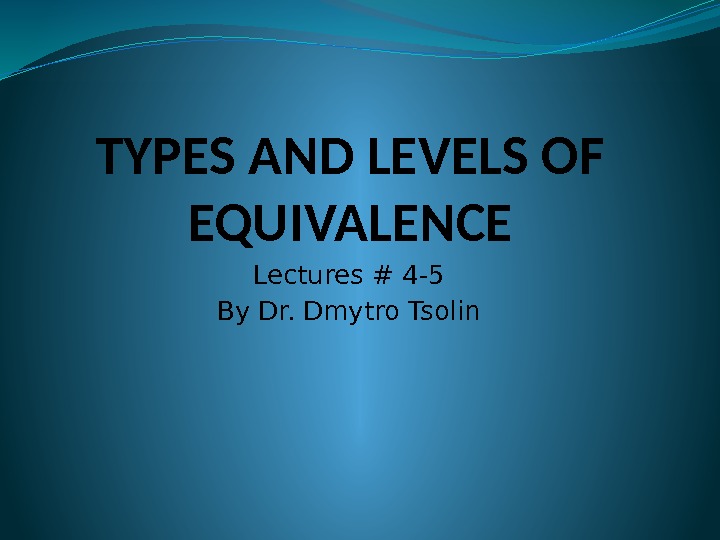
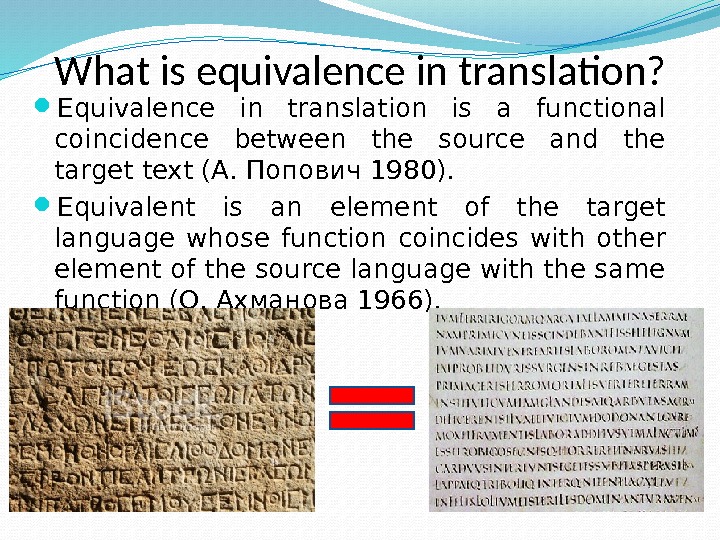
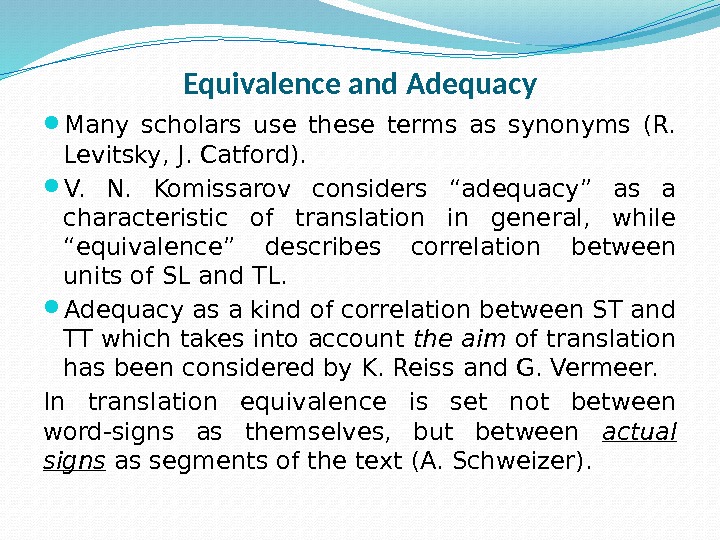
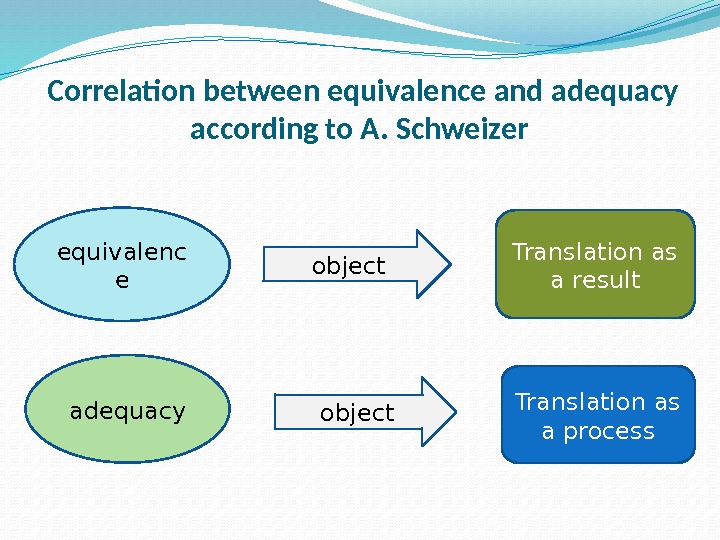
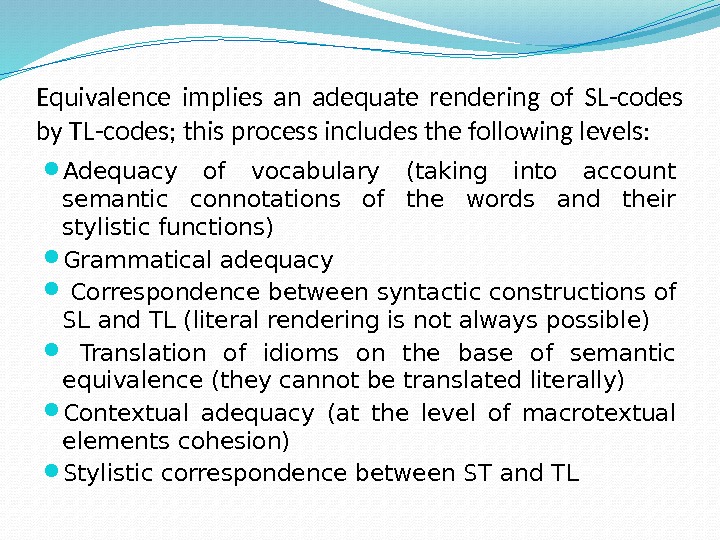
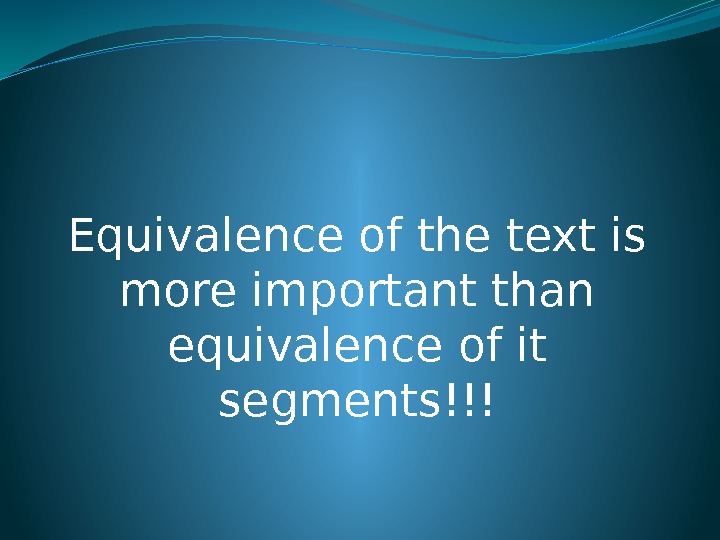
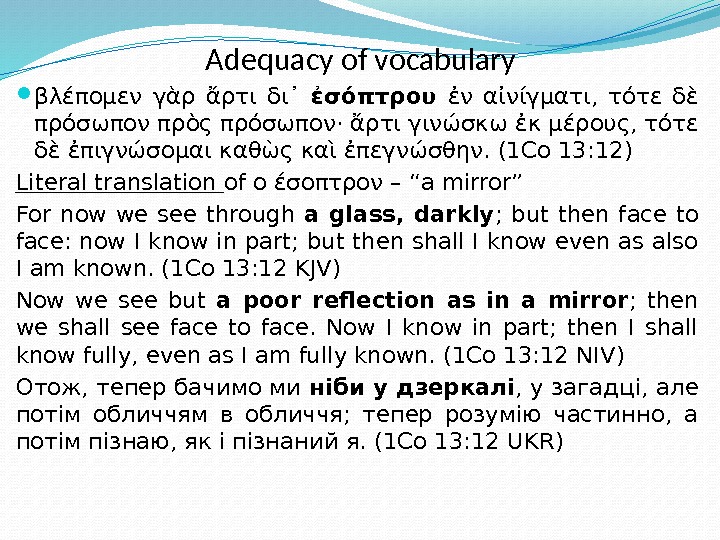
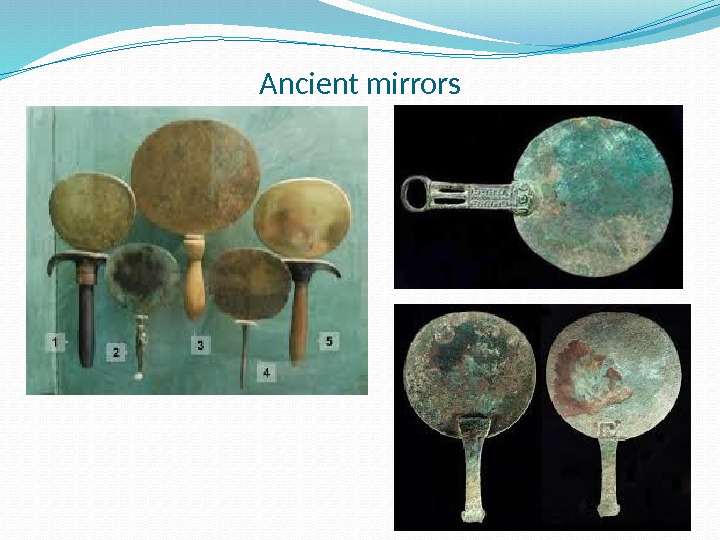
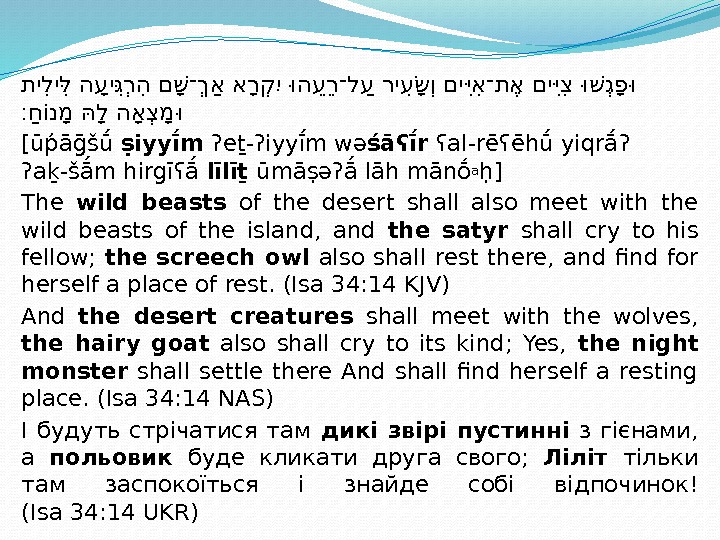
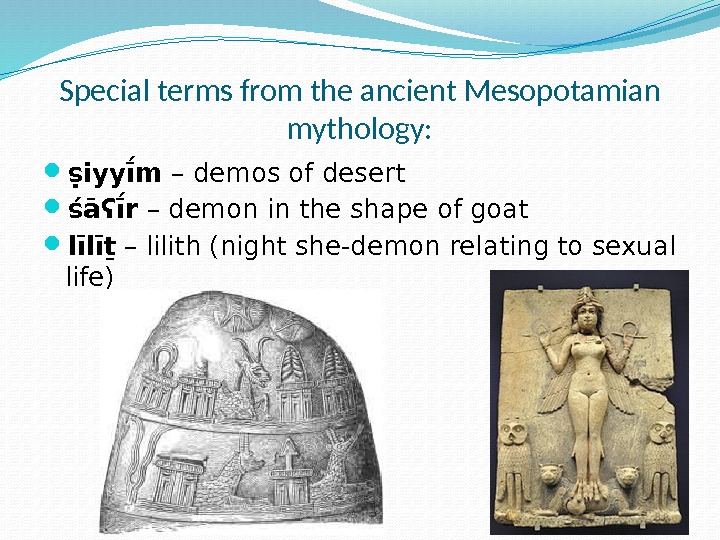
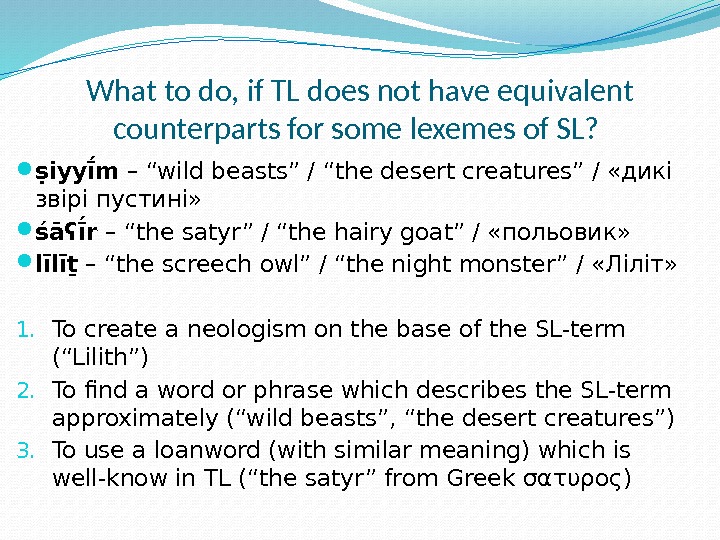
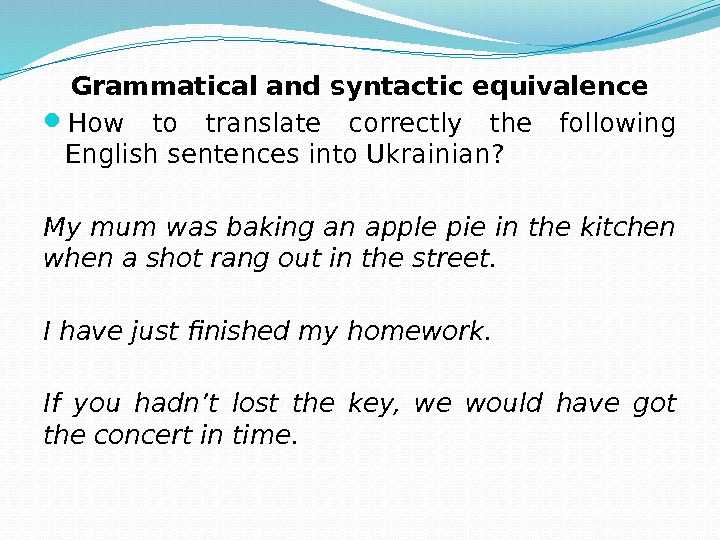
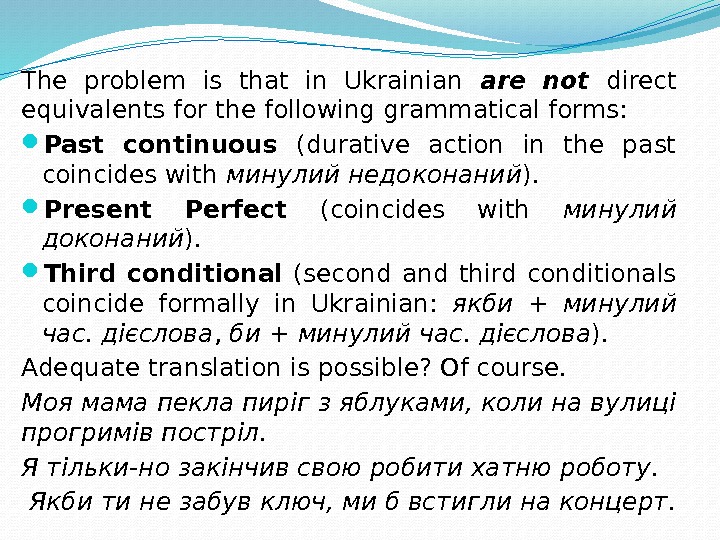
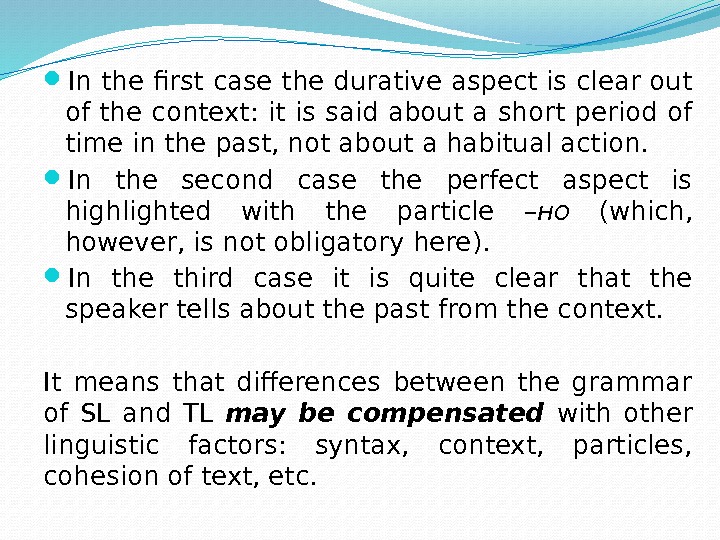
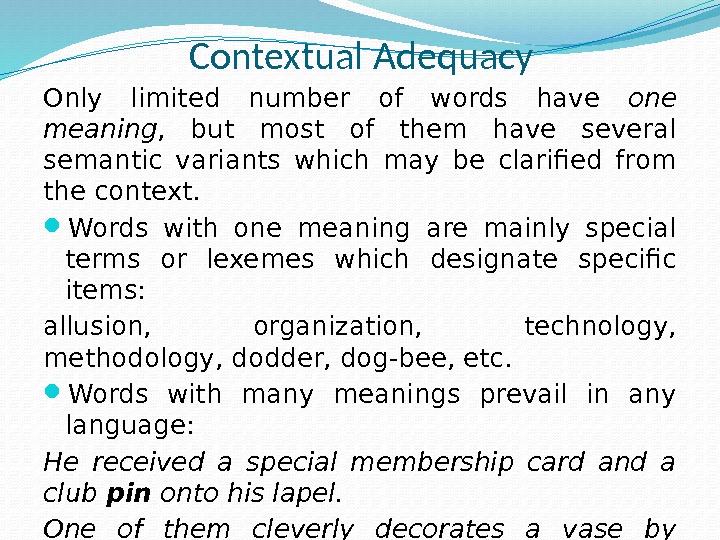
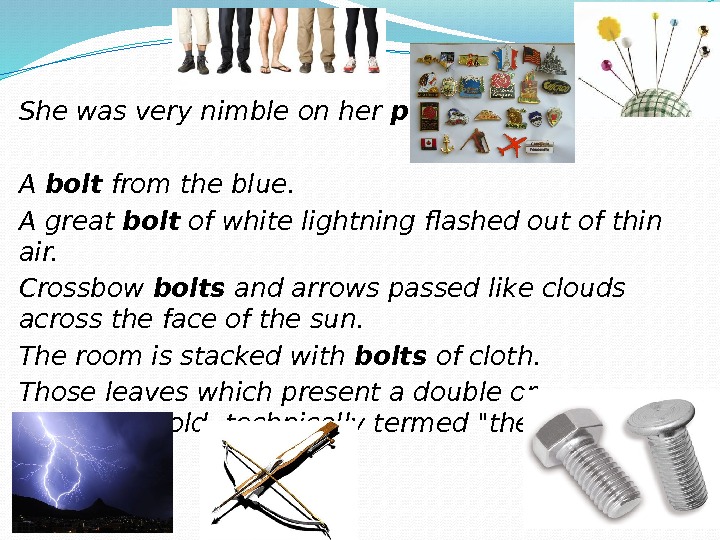

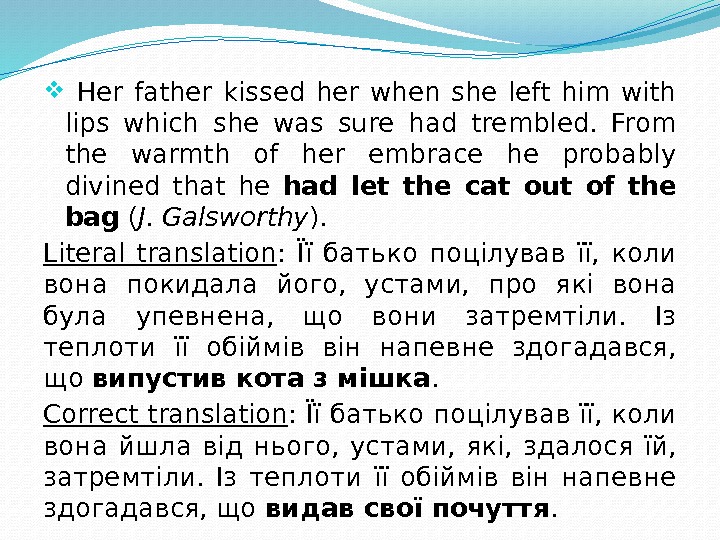
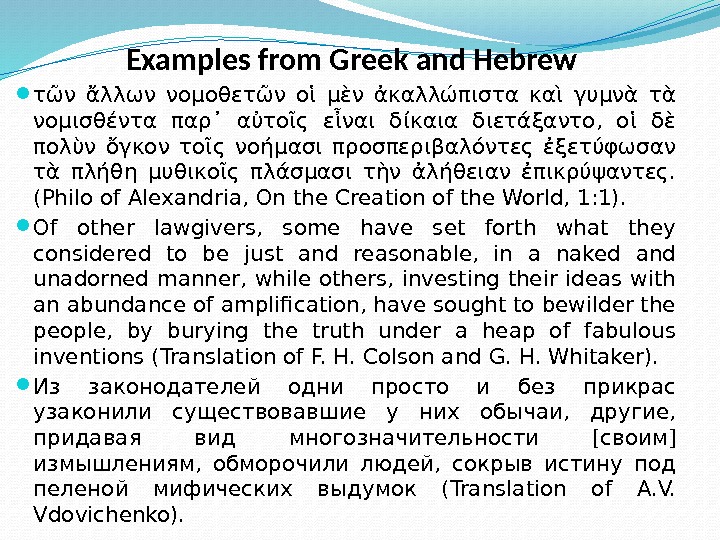
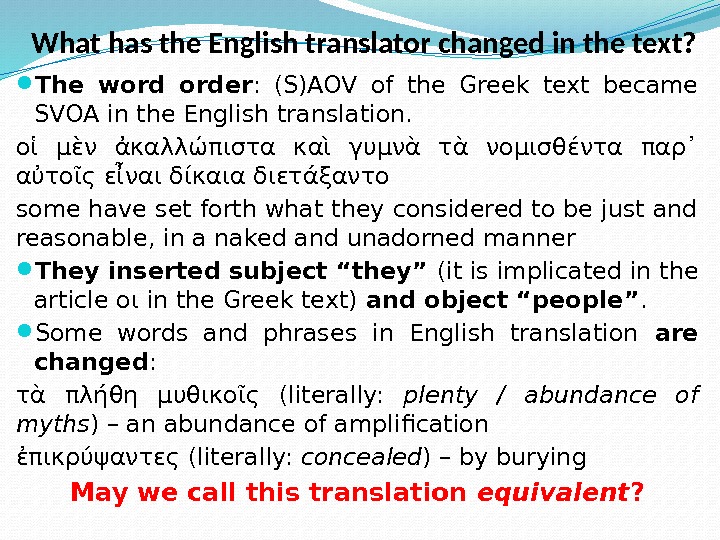
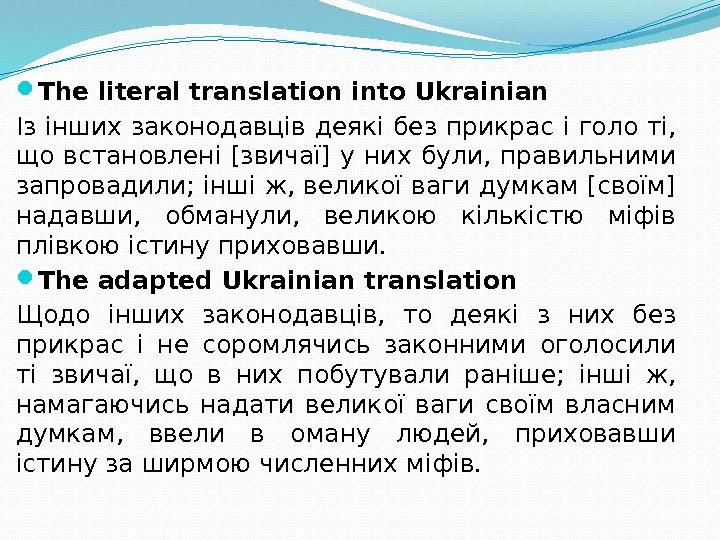
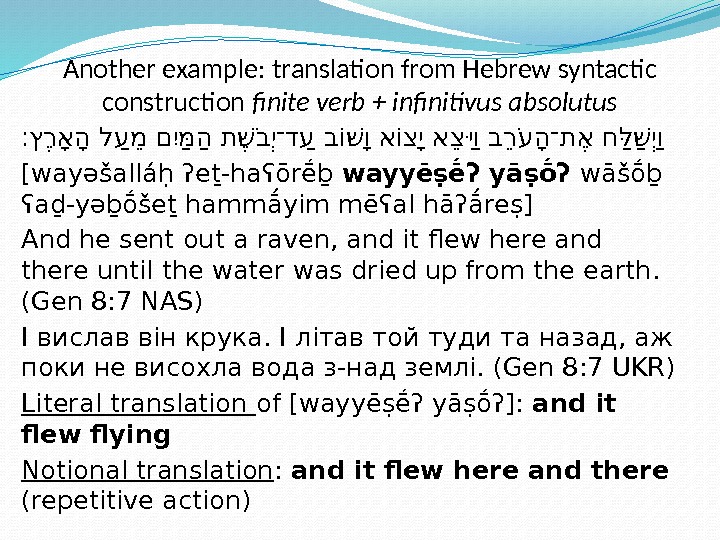
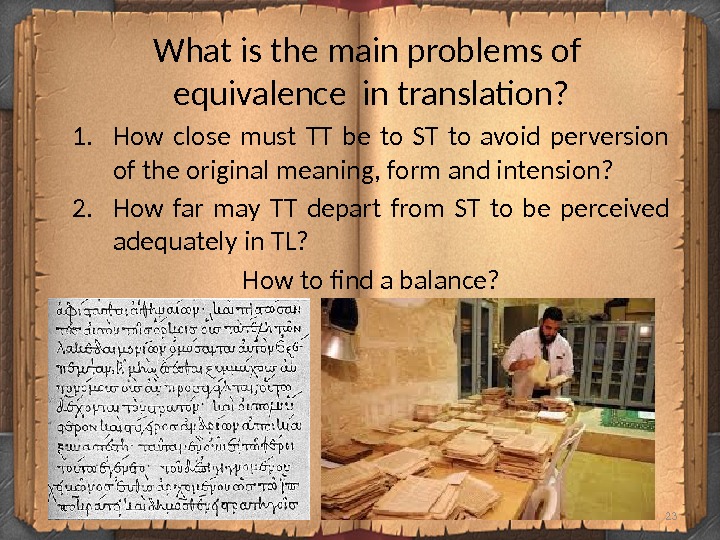
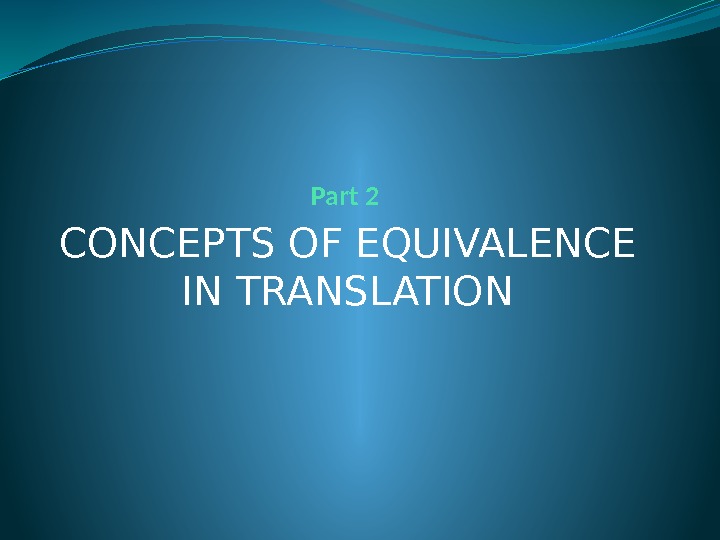
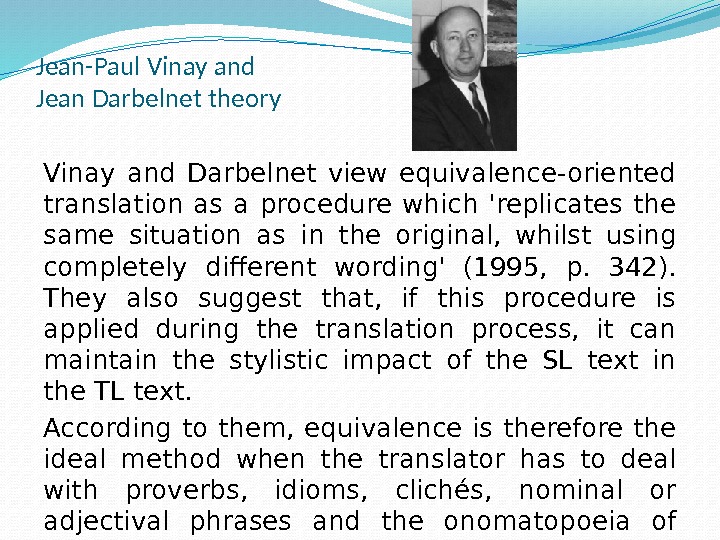
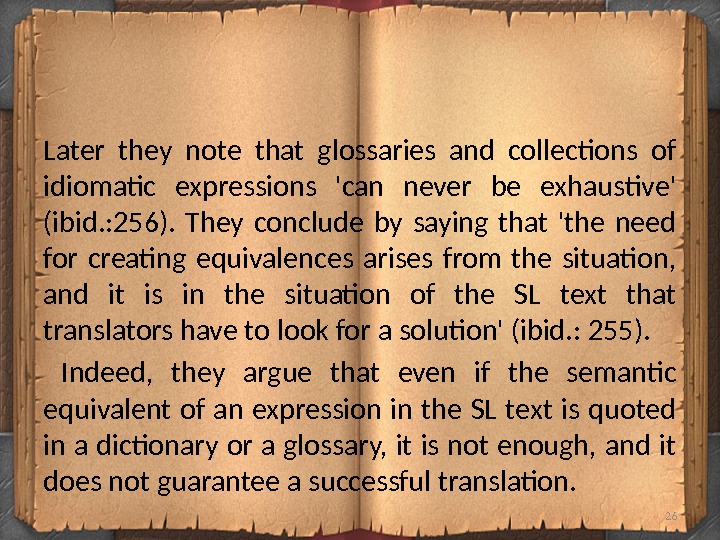
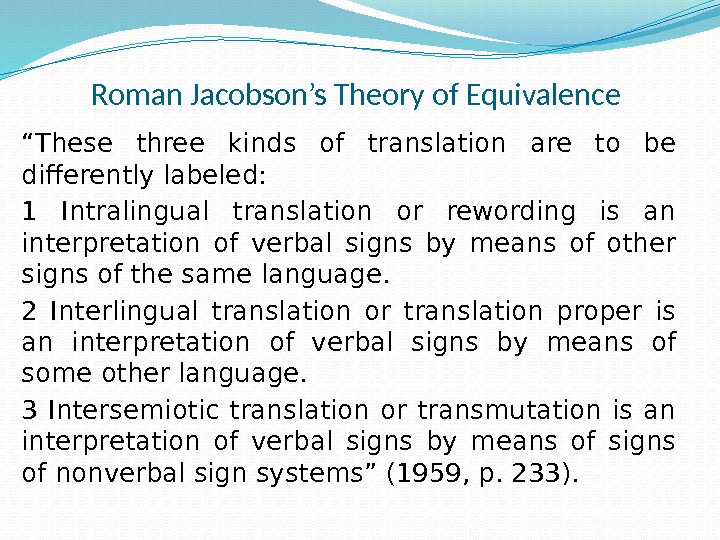
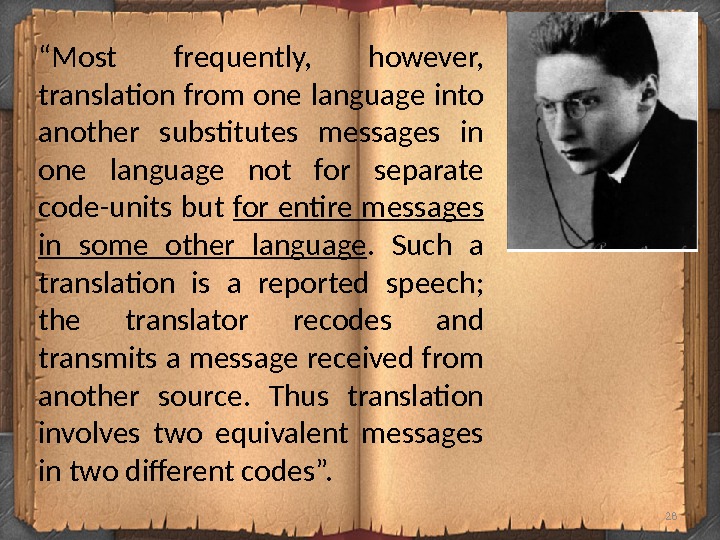
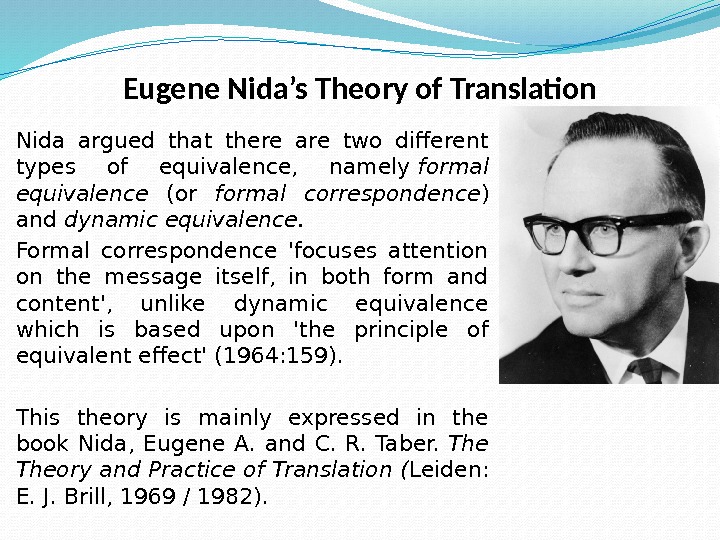
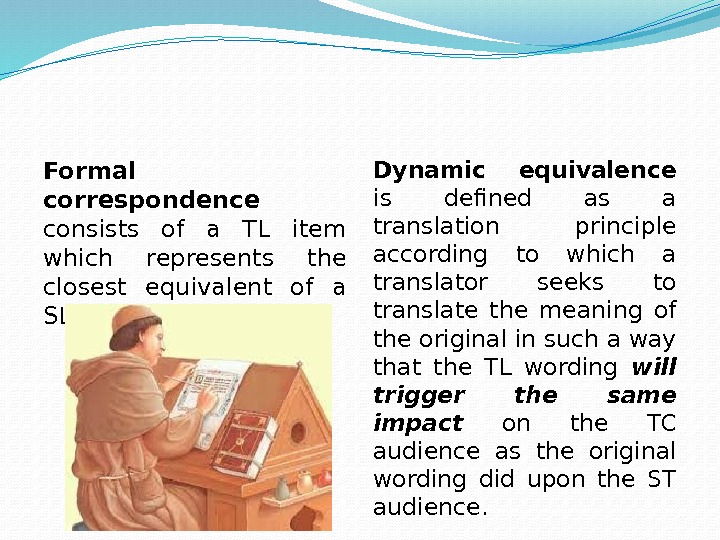
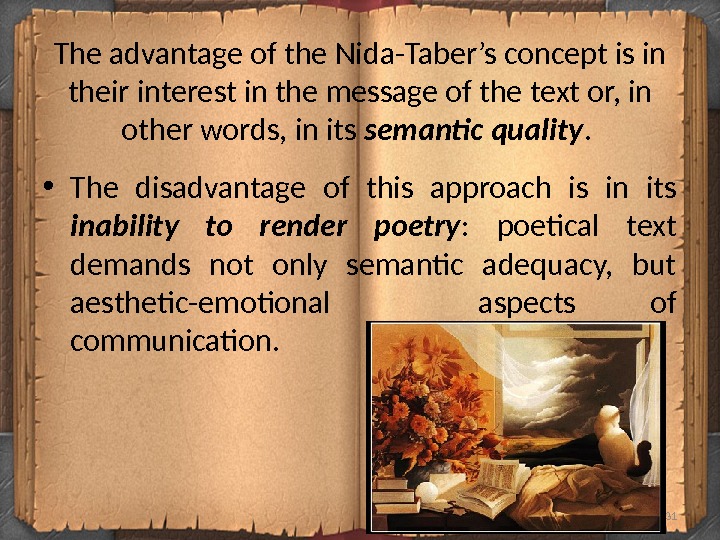
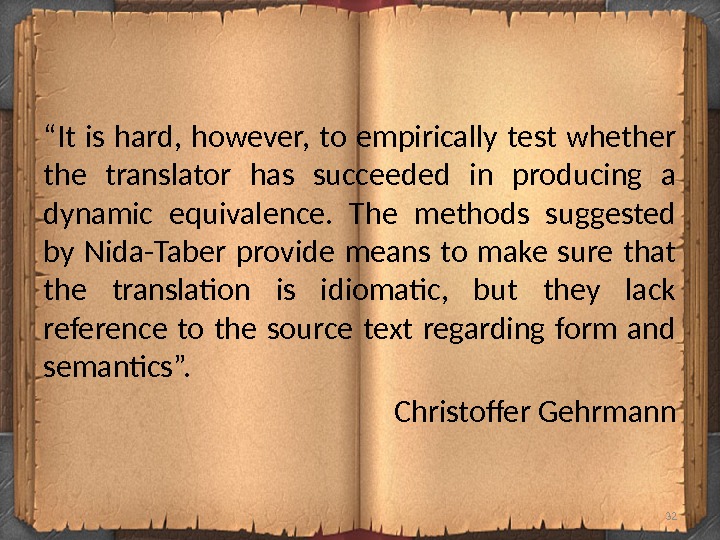
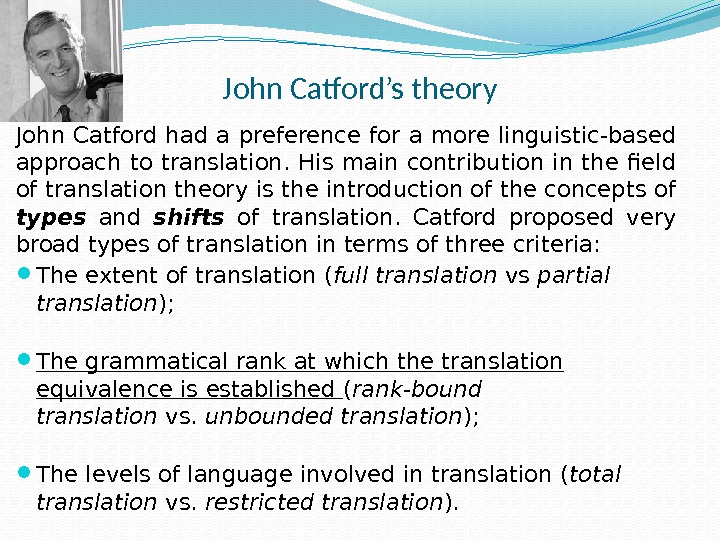
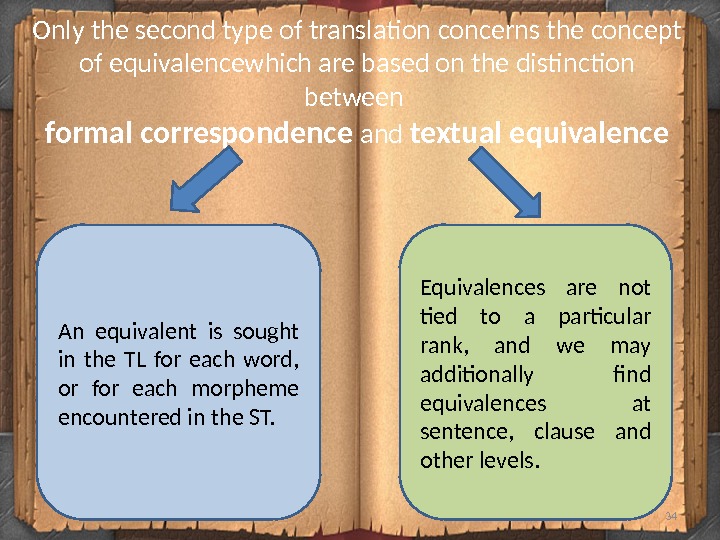
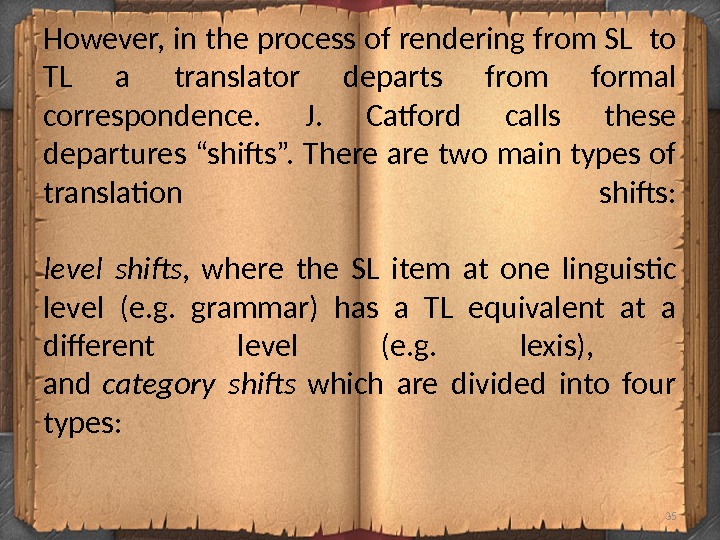
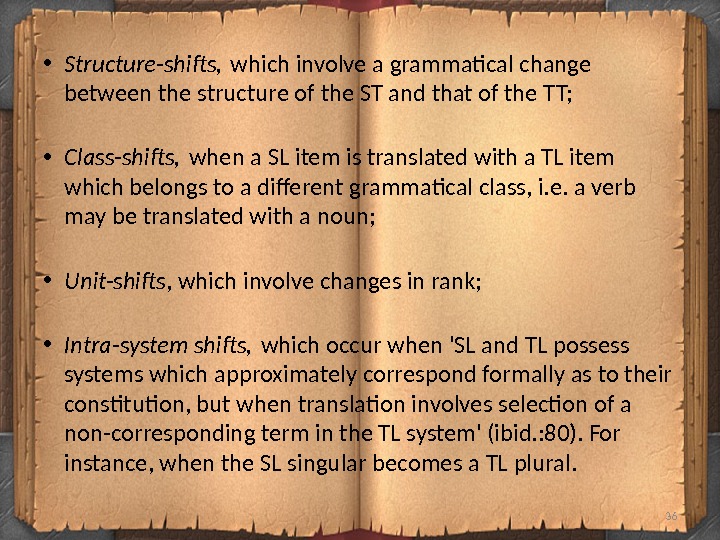
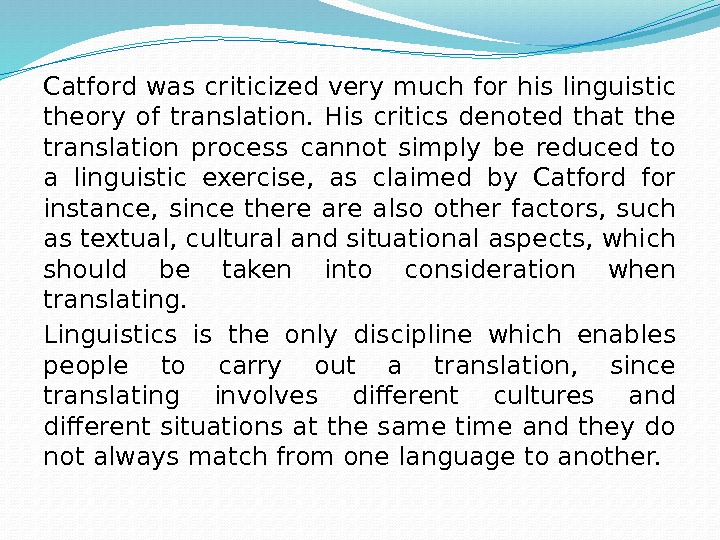
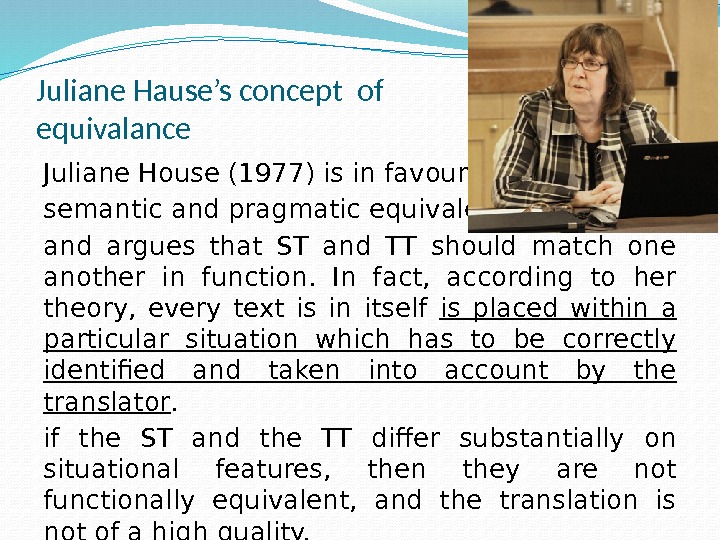
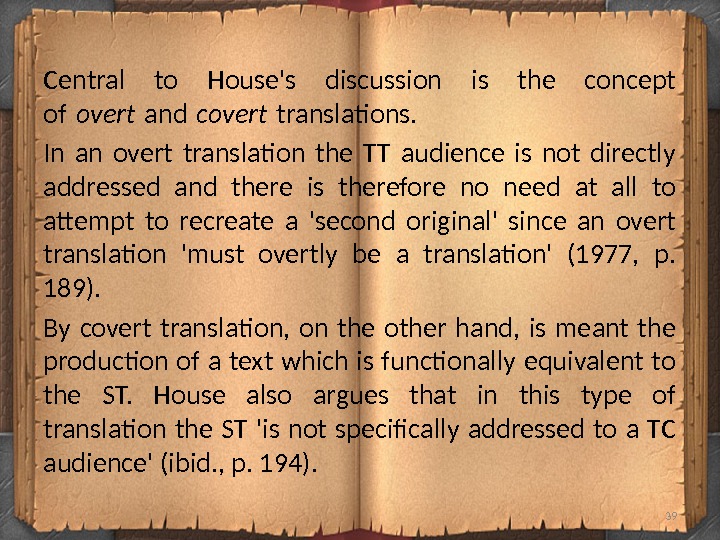
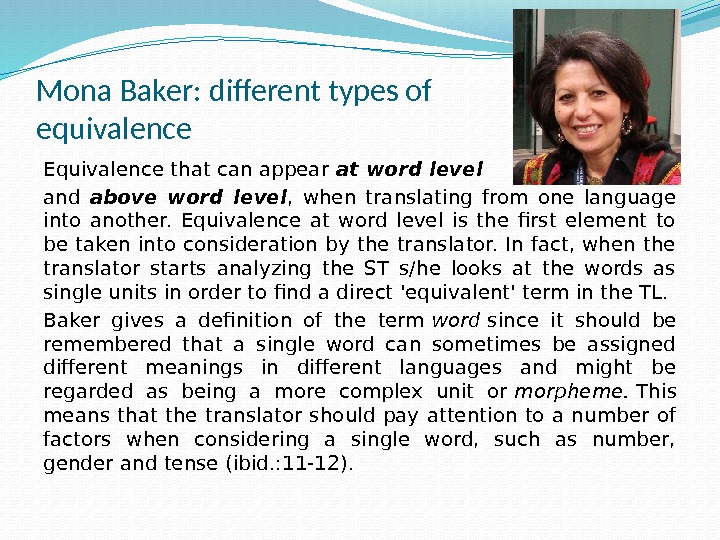
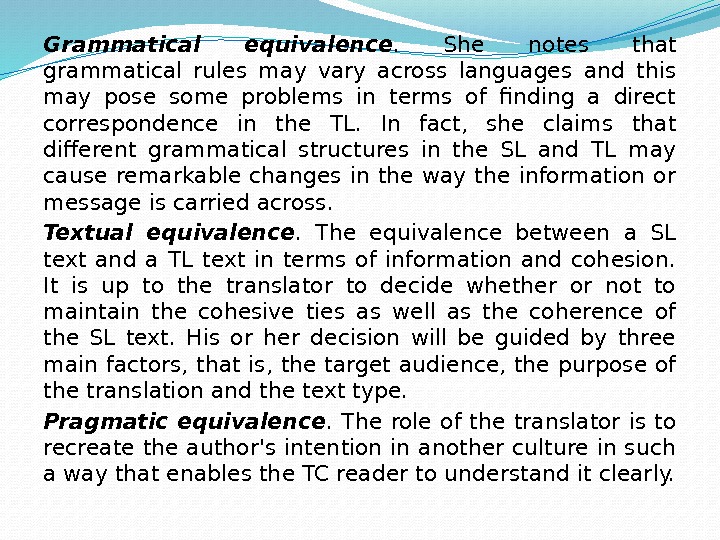
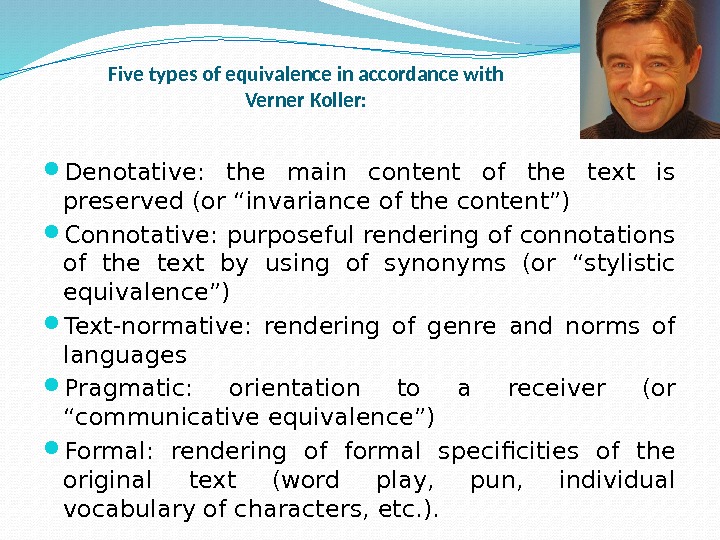
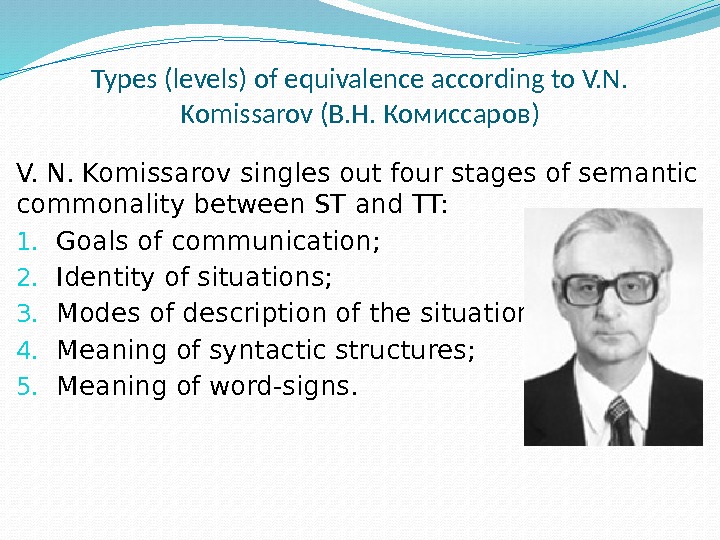
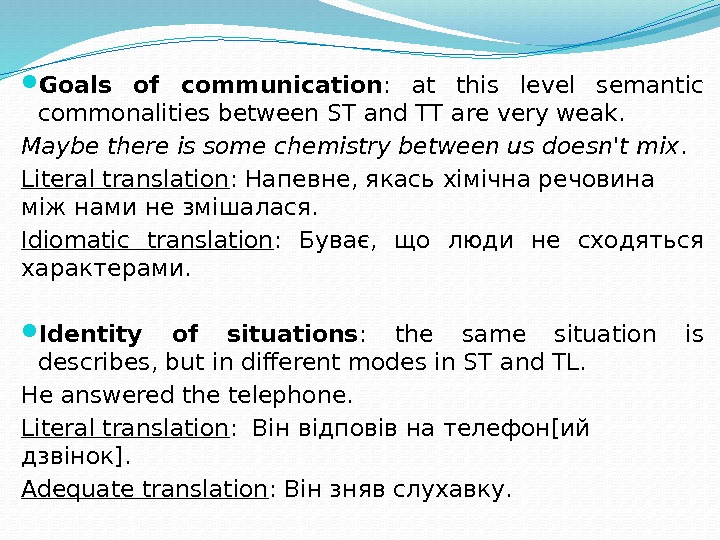
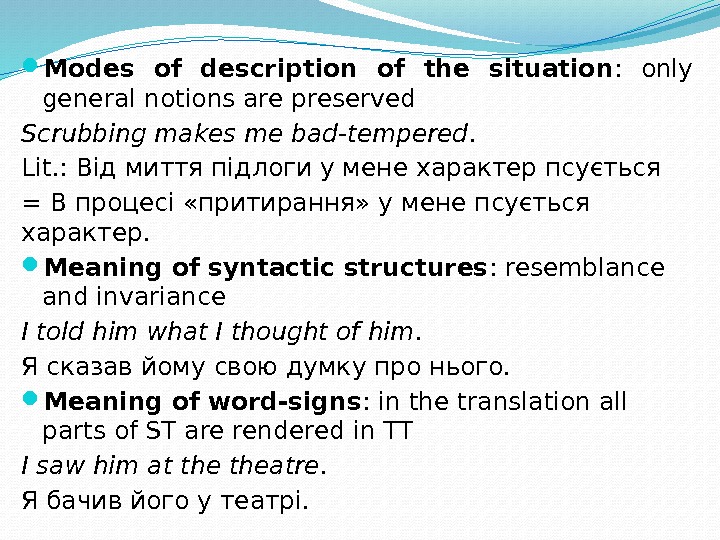
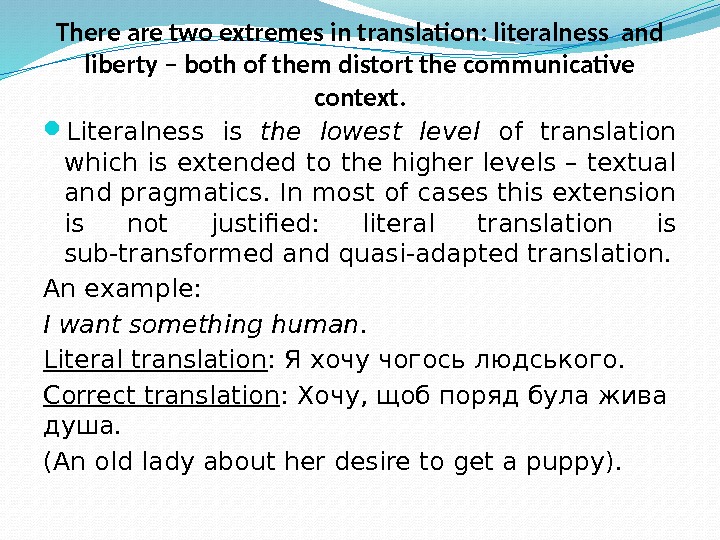
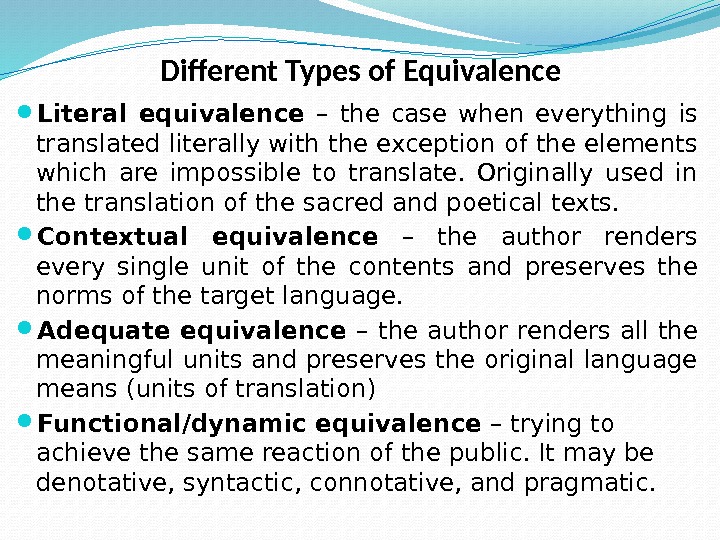
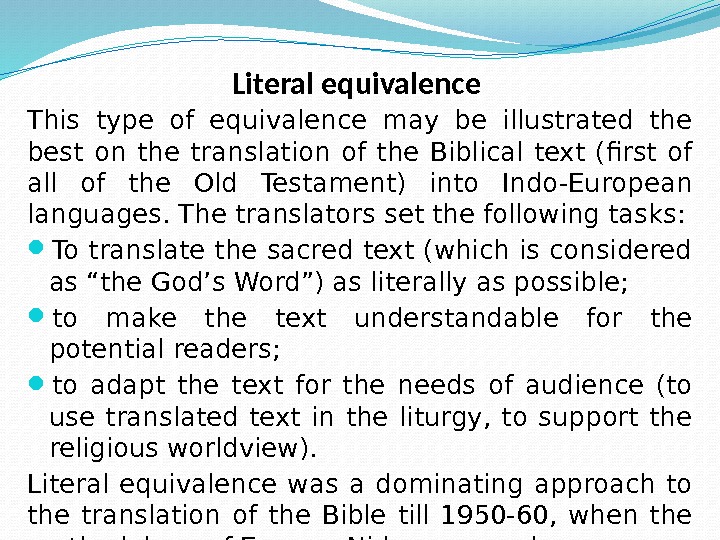
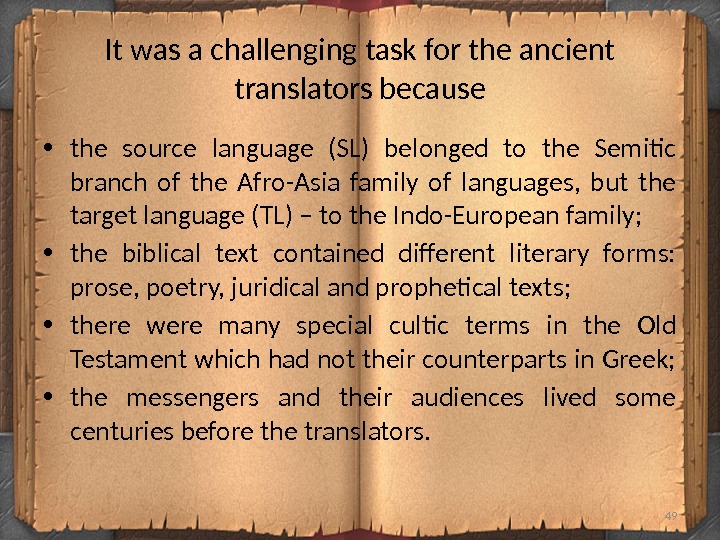
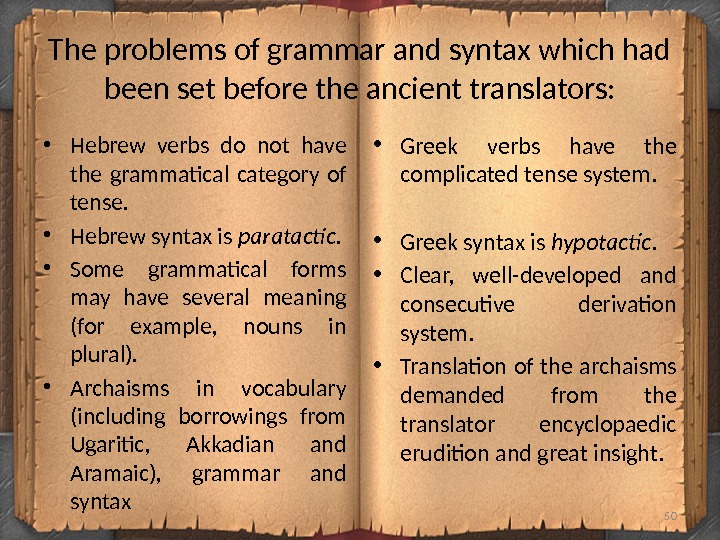

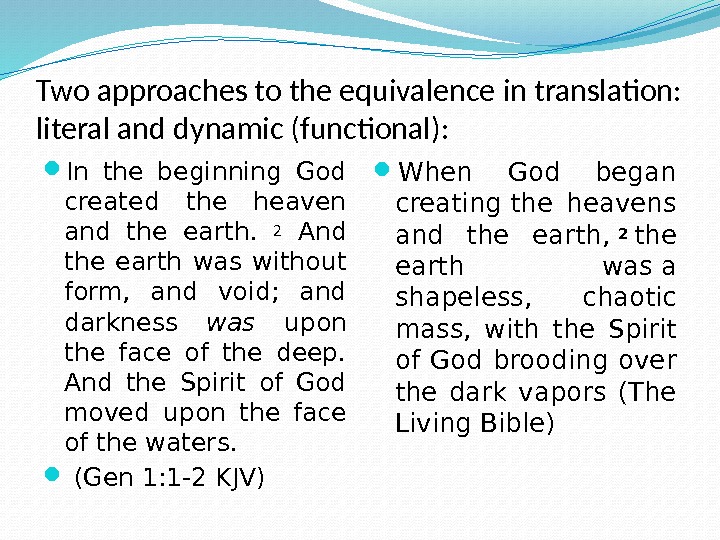
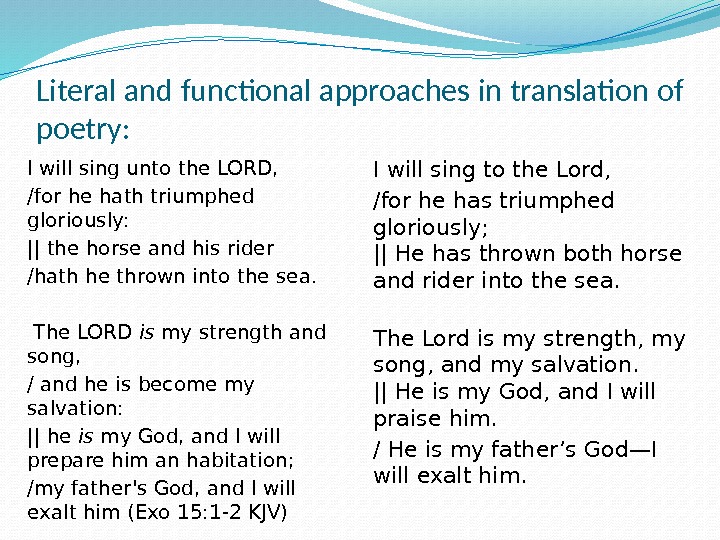
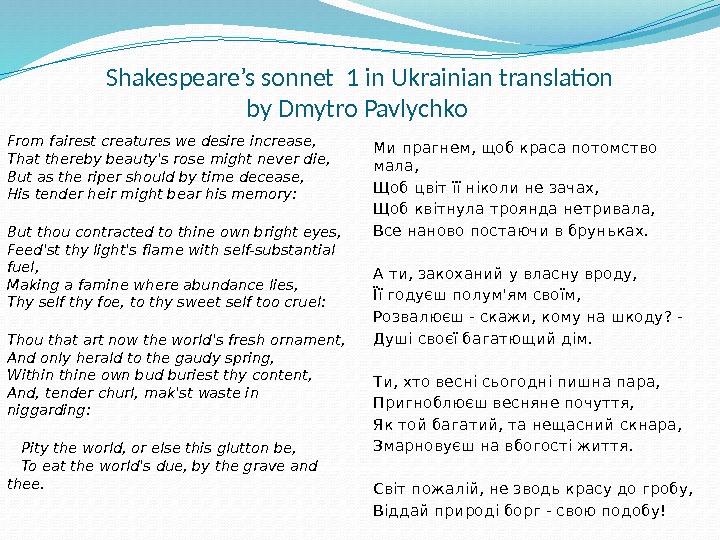
lecture_4-5.pptx
- Размер: 7.7 Мб
- Автор:
- Количество слайдов: 54
Описание презентации TYPES AND LEVELS OF EQUIVALENCE Lectures # 4 по слайдам
 TYPES AND LEVELS OF EQUIVALENCE Lectures # 4 -5 By Dr. Dmytro Tsolin
TYPES AND LEVELS OF EQUIVALENCE Lectures # 4 -5 By Dr. Dmytro Tsolin
 What is equivalence in translation? Equivalence in translation is a functional coincidence between the source and the target text (А. Попович 1980). Equivalent is an element of the target language whose function coincides with other element of the source language with the same function (О. Ахманова 1966).
What is equivalence in translation? Equivalence in translation is a functional coincidence between the source and the target text (А. Попович 1980). Equivalent is an element of the target language whose function coincides with other element of the source language with the same function (О. Ахманова 1966).
 Equivalence and Adequacy Many scholars use these terms as synonyms (R. Levitsky, J. Catford). V. N. Komissarov considers “adequacy” as a characteristic of translation in general, while “equivalence” describes correlation between units of SL and TL. Adequacy as a kind of correlation between ST and TT which takes into account the aim of translation has been considered by K. Reiss and G. Vermeer. In translation equivalence is set not between word-signs as themselves, but between actual signs as segments of the text (A. Schweizer).
Equivalence and Adequacy Many scholars use these terms as synonyms (R. Levitsky, J. Catford). V. N. Komissarov considers “adequacy” as a characteristic of translation in general, while “equivalence” describes correlation between units of SL and TL. Adequacy as a kind of correlation between ST and TT which takes into account the aim of translation has been considered by K. Reiss and G. Vermeer. In translation equivalence is set not between word-signs as themselves, but between actual signs as segments of the text (A. Schweizer).
 Correlation between equivalence and adequacy according to A. Schweizer equivalenc e adequacy object Translation as a result Translation as a process
Correlation between equivalence and adequacy according to A. Schweizer equivalenc e adequacy object Translation as a result Translation as a process
 Equivalence implies an adequate rendering of SL-codes by TL-codes; this process includes the following levels: Adequacy of vocabulary (taking into account semantic connotations of the words and their stylistic functions) Grammatical adequacy Correspondence between syntactic constructions of SL and TL (literal rendering is not always possible) Translation of idioms on the base of semantic equivalence (they cannot be translated literally) Contextual adequacy (at the level of macrotextual elements cohesion) Stylistic correspondence between ST and TL
Equivalence implies an adequate rendering of SL-codes by TL-codes; this process includes the following levels: Adequacy of vocabulary (taking into account semantic connotations of the words and their stylistic functions) Grammatical adequacy Correspondence between syntactic constructions of SL and TL (literal rendering is not always possible) Translation of idioms on the base of semantic equivalence (they cannot be translated literally) Contextual adequacy (at the level of macrotextual elements cohesion) Stylistic correspondence between ST and TL
 Equivalence of the text is more important than equivalence of it segments!!!
Equivalence of the text is more important than equivalence of it segments!!!
 Adequacy of vocabulary βλέπομεν γὰρ ἄρτι δι᾽ ἐσόπτρου ἐν αἰνίγματι, τότε δὲ πρόσωπον πρὸς πρόσωπον· ἄρτι γινώσκω ἐκ μέρους, τότε δὲ ἐπιγνώσομαι καθὼς καὶ ἐπεγνώσθην. (1 Co 13: 12) Literal translation of ο εσοπτρον – “a mirror” For now we see through a glass, darkly ; but then face to face: now I know in part; but then shall I know even as also I am known. (1 Co 13: 12 KJV) Now we see but a poor reflection as in a mirror ; then we shall see face to face. Now I know in part; then I shall know fully, even as I am fully known. (1 Co 13: 12 NIV) Отож, тепер бачимо ми ніби у дзеркалі , у загадці, але потім обличчям в обличчя; тепер розумію частинно, а потім пізнаю, як і пізнаний я. (1 Co 13: 12 UKR)
Adequacy of vocabulary βλέπομεν γὰρ ἄρτι δι᾽ ἐσόπτρου ἐν αἰνίγματι, τότε δὲ πρόσωπον πρὸς πρόσωπον· ἄρτι γινώσκω ἐκ μέρους, τότε δὲ ἐπιγνώσομαι καθὼς καὶ ἐπεγνώσθην. (1 Co 13: 12) Literal translation of ο εσοπτρον – “a mirror” For now we see through a glass, darkly ; but then face to face: now I know in part; but then shall I know even as also I am known. (1 Co 13: 12 KJV) Now we see but a poor reflection as in a mirror ; then we shall see face to face. Now I know in part; then I shall know fully, even as I am fully known. (1 Co 13: 12 NIV) Отож, тепер бачимо ми ніби у дзеркалі , у загадці, але потім обличчям в обличчя; тепер розумію частинно, а потім пізнаю, як і пізнаний я. (1 Co 13: 12 UKR)
 Ancient mirrors
Ancient mirrors
 תיתלל ה עעיתגל רר ה ל ם השע ־שךר א א רע קר י וה עערע ־שלעע ריתעלשע ור ם היתיל א ל ־שתא א ם היתיל צל ושגר פע ו ׃חע ונומע הלע ה אצר מע ו [ūṕāḡšū ū ṣiyyīīm ʔeṯ-ʔiyyīūm wə śāʕīīr ʕal-rēʕēhūū yiqrāūʔ ʔaḵ-šā ūm hirgīʕāū līlīṯ ūmāṣəʔāū lāh mānō a ḥ] The wild beasts of the desert shall also meet with the wild beasts of the island, and the satyr shall cry to his fellow; the screech owl also shall rest there, and find for herself a place of rest. (Isa 34: 14 KJV) And the desert creatures shall meet with the wolves, the hairy goat also shall cry to its kind; Yes, the night monster shall settle there And shall find herself a resting place. (Isa 34: 14 NAS) І будуть стрічатися там дикі звірі пустинні з гієнами, а польовик буде кликати друга свого; Ліліт тільки там заспокоїться і знайде собі відпочинок! (Isa 34: 14 UKR)
תיתלל ה עעיתגל רר ה ל ם השע ־שךר א א רע קר י וה עערע ־שלעע ריתעלשע ור ם היתיל א ל ־שתא א ם היתיל צל ושגר פע ו ׃חע ונומע הלע ה אצר מע ו [ūṕāḡšū ū ṣiyyīīm ʔeṯ-ʔiyyīūm wə śāʕīīr ʕal-rēʕēhūū yiqrāūʔ ʔaḵ-šā ūm hirgīʕāū līlīṯ ūmāṣəʔāū lāh mānō a ḥ] The wild beasts of the desert shall also meet with the wild beasts of the island, and the satyr shall cry to his fellow; the screech owl also shall rest there, and find for herself a place of rest. (Isa 34: 14 KJV) And the desert creatures shall meet with the wolves, the hairy goat also shall cry to its kind; Yes, the night monster shall settle there And shall find herself a resting place. (Isa 34: 14 NAS) І будуть стрічатися там дикі звірі пустинні з гієнами, а польовик буде кликати друга свого; Ліліт тільки там заспокоїться і знайде собі відпочинок! (Isa 34: 14 UKR)
 Special terms from the ancient Mesopotamian mythology: ṣiyyīīm – demos of desert śāʕī īr – demon in the shape of goat līlīṯ – lilith (night she-demon relating to sexual life)
Special terms from the ancient Mesopotamian mythology: ṣiyyīīm – demos of desert śāʕī īr – demon in the shape of goat līlīṯ – lilith (night she-demon relating to sexual life)
 What to do, if TL does not have equivalent counterparts for some lexemes of SL? ṣiyyīīm – “wild beasts” / “the desert creatures” / «дикі звірі пустині» śāʕī īr – “the satyr” / “the hairy goat” / «польовик» līlīṯ – “the screech owl” / “the night monster” / «Ліліт» 1. To create a neologism on the base of the SL-term (“Lilith”) 2. To find a word or phrase which describes the SL-term approximately (“wild beasts”, “the desert creatures”) 3. To use a loanword (with similar meaning) which is well-know in TL (“the satyr” from Greek σατυρος)
What to do, if TL does not have equivalent counterparts for some lexemes of SL? ṣiyyīīm – “wild beasts” / “the desert creatures” / «дикі звірі пустині» śāʕī īr – “the satyr” / “the hairy goat” / «польовик» līlīṯ – “the screech owl” / “the night monster” / «Ліліт» 1. To create a neologism on the base of the SL-term (“Lilith”) 2. To find a word or phrase which describes the SL-term approximately (“wild beasts”, “the desert creatures”) 3. To use a loanword (with similar meaning) which is well-know in TL (“the satyr” from Greek σατυρος)
 Grammatical and syntactic equivalence How to translate correctly the following English sentences into Ukrainian? My mum was baking an apple pie in the kitchen when a shot rang out in the street. I have just finished my homework. If you hadn’t lost the key, we would have got the concert in time.
Grammatical and syntactic equivalence How to translate correctly the following English sentences into Ukrainian? My mum was baking an apple pie in the kitchen when a shot rang out in the street. I have just finished my homework. If you hadn’t lost the key, we would have got the concert in time.
 The problem is that in Ukrainian are not direct equivalents for the following grammatical forms: Past continuous (durative action in the past coincides with минулий недоконаний ). Present Perfect (coincides with минулий доконаний ). Third conditional (second and third conditionals coincide formally in Ukrainian: якби + минулий час. дієслова , би + минулий час. дієслова ). Adequate translation is possible? Of course. Моя мама пекла пиріг з яблуками, коли на вулиці прогримів постріл. Я тільки-но закінчив свою робити хатню роботу. Якби ти не забув ключ, ми б встигли на концерт.
The problem is that in Ukrainian are not direct equivalents for the following grammatical forms: Past continuous (durative action in the past coincides with минулий недоконаний ). Present Perfect (coincides with минулий доконаний ). Third conditional (second and third conditionals coincide formally in Ukrainian: якби + минулий час. дієслова , би + минулий час. дієслова ). Adequate translation is possible? Of course. Моя мама пекла пиріг з яблуками, коли на вулиці прогримів постріл. Я тільки-но закінчив свою робити хатню роботу. Якби ти не забув ключ, ми б встигли на концерт.
 In the first case the durative aspect is clear out of the context: it is said about a short period of time in the past, not about a habitual action. In the second case the perfect aspect is highlighted with the particle –но (which, however, is not obligatory here). In the third case it is quite clear that the speaker tells about the past from the context. It means that differences between the grammar of SL and TL may be compensated with other linguistic factors: syntax, context, particles, cohesion of text, etc.
In the first case the durative aspect is clear out of the context: it is said about a short period of time in the past, not about a habitual action. In the second case the perfect aspect is highlighted with the particle –но (which, however, is not obligatory here). In the third case it is quite clear that the speaker tells about the past from the context. It means that differences between the grammar of SL and TL may be compensated with other linguistic factors: syntax, context, particles, cohesion of text, etc.
 Contextual Adequacy Only limited number of words have one meaning , but most of them have several semantic variants which may be clarified from the context. Words with one meaning are mainly special terms or lexemes which designate specific items: allusion, organization, technology, methodology, dodder, dog-bee, etc. Words with many meanings prevail in any language: He received a special membership card and a club pin onto his lapel. One of them cleverly decorates a vase by drawing plant leaves using a sharp pin , while another shapes small frog-like figures to be put on ashtrays.
Contextual Adequacy Only limited number of words have one meaning , but most of them have several semantic variants which may be clarified from the context. Words with one meaning are mainly special terms or lexemes which designate specific items: allusion, organization, technology, methodology, dodder, dog-bee, etc. Words with many meanings prevail in any language: He received a special membership card and a club pin onto his lapel. One of them cleverly decorates a vase by drawing plant leaves using a sharp pin , while another shapes small frog-like figures to be put on ashtrays.
 She was very nimble on her pins. A bolt from the blue. A great bolt of white lightning flashed out of thin air. Crossbow bolts and arrows passed like clouds across the face of the sun. The room is stacked with bolts of cloth. Those leaves which present a double or quadruple fold, technically termed «the bolt «.
She was very nimble on her pins. A bolt from the blue. A great bolt of white lightning flashed out of thin air. Crossbow bolts and arrows passed like clouds across the face of the sun. The room is stacked with bolts of cloth. Those leaves which present a double or quadruple fold, technically termed «the bolt «.
 Translation of idioms: The captain held his peace that evening and for many evenings to come ( R. Stevenson ) Literal (mechanical) translation : Капітан тримав свій мир того вечора і протягом багатьох наступних вечорів. Correct translation : Капітан мовчав / тримав язик за зубами того вечора і протягом наступних вечорів. Miss Williams will look after you well because she knows the ropes ( J. Aldridge ) Literal translation : Міс Уільямс догляне тебе добре, бо вона знає мотузки. Correct translation : Міс Уільямс потурбується про тебе добре / належно, бо вона знає свою справу.
Translation of idioms: The captain held his peace that evening and for many evenings to come ( R. Stevenson ) Literal (mechanical) translation : Капітан тримав свій мир того вечора і протягом багатьох наступних вечорів. Correct translation : Капітан мовчав / тримав язик за зубами того вечора і протягом наступних вечорів. Miss Williams will look after you well because she knows the ropes ( J. Aldridge ) Literal translation : Міс Уільямс догляне тебе добре, бо вона знає мотузки. Correct translation : Міс Уільямс потурбується про тебе добре / належно, бо вона знає свою справу.
 Her father kissed her when she left him with lips which she was sure had trembled. From the warmth of her embrace he probably divined that he had let the cat out of the bag ( J. Galsworthy ). Literal translation : Її батько поцілував її, коли вона покидала його, устами, про які вона була упевнена, що вони затремтіли. Із теплоти її обіймів він напевне здогадався, що випустив кота з мішка. Correct translation : Її батько поцілував її, коли вона йшла від нього, устами, які, здалося їй, затремтіли. Із теплоти її обіймів він напевне здогадався, що видав свої почуття.
Her father kissed her when she left him with lips which she was sure had trembled. From the warmth of her embrace he probably divined that he had let the cat out of the bag ( J. Galsworthy ). Literal translation : Її батько поцілував її, коли вона покидала його, устами, про які вона була упевнена, що вони затремтіли. Із теплоти її обіймів він напевне здогадався, що випустив кота з мішка. Correct translation : Її батько поцілував її, коли вона йшла від нього, устами, які, здалося їй, затремтіли. Із теплоти її обіймів він напевне здогадався, що видав свої почуття.
 Examples from Greek and Hebrew τῶν ἄλλων νομοθετῶν οἱ μὲν ἀκαλλώπιστα καὶ γυμνὰ τὰ νομισθέντα παρ᾽ αὐτοῖς εἶναι δίκαια διετάξαντο, οἱ δὲ πολὺν ὄγκον τοῖς νοήμασι προσπεριβαλόντες ἐξετύφωσαν τὰ πλήθη μυθικοῖς πλάσμασι τὴν ἀλήθειαν ἐπικρύψαντες. (Philo of Alexandria, On the Creation of the World, 1: 1). Of other lawgivers, some have set forth what they considered to be just and reasonable, in a naked and unadorned manner, while others, investing their ideas with an abundance of amplification, have sought to bewilder the people, by burying the truth under a heap of fabulous inventions (Translation of F. H. Colson and G. H. Whitaker). Из законодателей одни просто и без прикрас узаконили существовавшие у них обычаи, другие, придавая вид многозначительности [своим] измышлениям, обморочили людей, сокрыв истину под пеленой мифических выдумок (Translation of A. V. Vdovichenko).
Examples from Greek and Hebrew τῶν ἄλλων νομοθετῶν οἱ μὲν ἀκαλλώπιστα καὶ γυμνὰ τὰ νομισθέντα παρ᾽ αὐτοῖς εἶναι δίκαια διετάξαντο, οἱ δὲ πολὺν ὄγκον τοῖς νοήμασι προσπεριβαλόντες ἐξετύφωσαν τὰ πλήθη μυθικοῖς πλάσμασι τὴν ἀλήθειαν ἐπικρύψαντες. (Philo of Alexandria, On the Creation of the World, 1: 1). Of other lawgivers, some have set forth what they considered to be just and reasonable, in a naked and unadorned manner, while others, investing their ideas with an abundance of amplification, have sought to bewilder the people, by burying the truth under a heap of fabulous inventions (Translation of F. H. Colson and G. H. Whitaker). Из законодателей одни просто и без прикрас узаконили существовавшие у них обычаи, другие, придавая вид многозначительности [своим] измышлениям, обморочили людей, сокрыв истину под пеленой мифических выдумок (Translation of A. V. Vdovichenko).
 What has the English translator changed in the text? The word order : (S)AOV of the Greek text became SVOA in the English translation. οἱ μὲν ἀκαλλώπιστα καὶ γυμνὰ τὰ νομισθέντα παρ᾽ αὐτοῖς εἶναι δίκαια διετάξαντο some have set forth what they considered to be just and reasonable, in a naked and unadorned manner They inserted subject “they” (it is implicated in the article οι in the Greek text) and object “people”. Some words and phrases in English translation are changed : τὰ πλήθη μυθικοῖς (literally: plenty / abundance of myths ) – an abundance of amplification ἐπικρύψαντες (literally: concealed ) – by burying May we call this translation equivalent ?
What has the English translator changed in the text? The word order : (S)AOV of the Greek text became SVOA in the English translation. οἱ μὲν ἀκαλλώπιστα καὶ γυμνὰ τὰ νομισθέντα παρ᾽ αὐτοῖς εἶναι δίκαια διετάξαντο some have set forth what they considered to be just and reasonable, in a naked and unadorned manner They inserted subject “they” (it is implicated in the article οι in the Greek text) and object “people”. Some words and phrases in English translation are changed : τὰ πλήθη μυθικοῖς (literally: plenty / abundance of myths ) – an abundance of amplification ἐπικρύψαντες (literally: concealed ) – by burying May we call this translation equivalent ?
 The literal translation into Ukrainian Із інших законодавців деякі без прикрас і голо ті, що встановлені [звичаї] у них були, правильними запровадили; інші ж, великої ваги думкам [своїм] надавши, обманули, великою кількістю міфів плівкою істину приховавши. The adapted Ukrainian translation Щодо інших законодавців, то деякі з них без прикрас і не соромлячись законними оголосили ті звичаї, що в них побутували раніше; інші ж, намагаючись надати великої ваги своїм власним думкам, ввели в оману людей, приховавши істину за ширмою численних міфів.
The literal translation into Ukrainian Із інших законодавців деякі без прикрас і голо ті, що встановлені [звичаї] у них були, правильними запровадили; інші ж, великої ваги думкам [своїм] надавши, обманули, великою кількістю міфів плівкою істину приховавши. The adapted Ukrainian translation Щодо інших законодавців, то деякі з них без прикрас і не соромлячись законними оголосили ті звичаї, що в них побутували раніше; інші ж, намагаючись надати великої ваги своїм власним думкам, ввели в оману людей, приховавши істину за ширмою численних міфів.
 Another example: translation from Hebrew syntactic construction finite verb + infinitivus absolutus ׃ץ׃רא אה ע לעעמע ם הימע ה ע תשא בביתר ־שד־עע בושוע א וציתע א צע יע וע ברע בעה ע ־שתא א חלע שע יתר וע [wayəšallaḥ ʔeṯ-haʕōrēḇ wayyēṣēʔ yāṣōʔ wāšōḇ ʕaḏ-yəḇōšeṯ hammā ūyim mēʕal hāʔāūreṣ] And he sent out a raven, and it flew here and there until the water was dried up from the earth. (Gen 8: 7 NAS) І вислав він крука. І літав той туди та назад, аж поки не висохла вода з-над землі. (Gen 8: 7 UKR) Literal translation of [wayyēṣēʔ yāṣōʔ]: and it flew flying Notional translation : and it flew here and there (repetitive action)
Another example: translation from Hebrew syntactic construction finite verb + infinitivus absolutus ׃ץ׃רא אה ע לעעמע ם הימע ה ע תשא בביתר ־שד־עע בושוע א וציתע א צע יע וע ברע בעה ע ־שתא א חלע שע יתר וע [wayəšallaḥ ʔeṯ-haʕōrēḇ wayyēṣēʔ yāṣōʔ wāšōḇ ʕaḏ-yəḇōšeṯ hammā ūyim mēʕal hāʔāūreṣ] And he sent out a raven, and it flew here and there until the water was dried up from the earth. (Gen 8: 7 NAS) І вислав він крука. І літав той туди та назад, аж поки не висохла вода з-над землі. (Gen 8: 7 UKR) Literal translation of [wayyēṣēʔ yāṣōʔ]: and it flew flying Notional translation : and it flew here and there (repetitive action)
 What is the main problems of equivalence in translation? 1. How close must TT be to ST to avoid perversion of the original meaning, form and intension? 2. How far may TT depart from ST to be perceived adequately in TL? How to find a balance?
What is the main problems of equivalence in translation? 1. How close must TT be to ST to avoid perversion of the original meaning, form and intension? 2. How far may TT depart from ST to be perceived adequately in TL? How to find a balance?
 Part 2 CONCEPTS OF EQUIVALENCE IN TRANSLATION
Part 2 CONCEPTS OF EQUIVALENCE IN TRANSLATION
 Jean-Paul Vinay and Jean Darbelnet theory Vinay and Darbelnet view equivalence-oriented translation as a procedure which ‘replicates the same situation as in the original, whilst using completely different wording’ (1995, p. 342). They also suggest that, if this procedure is applied during the translation process, it can maintain the stylistic impact of the SL text in the TL text. According to them, equivalence is therefore the ideal method when the translator has to deal with proverbs, idioms, clichés, nominal or adjectival phrases and the onomatopoeia of animal sounds.
Jean-Paul Vinay and Jean Darbelnet theory Vinay and Darbelnet view equivalence-oriented translation as a procedure which ‘replicates the same situation as in the original, whilst using completely different wording’ (1995, p. 342). They also suggest that, if this procedure is applied during the translation process, it can maintain the stylistic impact of the SL text in the TL text. According to them, equivalence is therefore the ideal method when the translator has to deal with proverbs, idioms, clichés, nominal or adjectival phrases and the onomatopoeia of animal sounds.
 Later they note that glossaries and collections of idiomatic expressions ‘can never be exhaustive’ (ibid. : 256). They conclude by saying that ‘the need for creating equivalences arises from the situation, and it is in the situation of the SL text that translators have to look for a solution’ (ibid. : 255). Indeed, they argue that even if the semantic equivalent of an expression in the SL text is quoted in a dictionary or a glossary, it is not enough, and it does not guarantee a successful translation.
Later they note that glossaries and collections of idiomatic expressions ‘can never be exhaustive’ (ibid. : 256). They conclude by saying that ‘the need for creating equivalences arises from the situation, and it is in the situation of the SL text that translators have to look for a solution’ (ibid. : 255). Indeed, they argue that even if the semantic equivalent of an expression in the SL text is quoted in a dictionary or a glossary, it is not enough, and it does not guarantee a successful translation.
 Roman Jacobson’s Theory of Equivalence “ These three kinds of translation are to be differently labeled: 1 Intralingual translation or rewording is an interpretation of verbal signs by means of other signs of the same language. 2 Interlingual translation or translation proper is an interpretation of verbal signs by means of some other language. 3 Intersemiotic translation or transmutation is an interpretation of verbal signs by means of signs of nonverbal sign systems” (1959, p. 233).
Roman Jacobson’s Theory of Equivalence “ These three kinds of translation are to be differently labeled: 1 Intralingual translation or rewording is an interpretation of verbal signs by means of other signs of the same language. 2 Interlingual translation or translation proper is an interpretation of verbal signs by means of some other language. 3 Intersemiotic translation or transmutation is an interpretation of verbal signs by means of signs of nonverbal sign systems” (1959, p. 233).
 “ Most frequently, however, translation from one language into another substitutes messages in one language not for separate code-units but for entire messages in some other language. Such a translation is a reported speech; the translator recodes and transmits a message received from another source. Thus translation involves two equivalent messages in two different codes”.
“ Most frequently, however, translation from one language into another substitutes messages in one language not for separate code-units but for entire messages in some other language. Such a translation is a reported speech; the translator recodes and transmits a message received from another source. Thus translation involves two equivalent messages in two different codes”.
 Eugene Nida’s Theory of Translation Nida argued that there are two different types of equivalence, namely formal equivalence (or formal correspondence ) and dynamic equivalence. Formal correspondence ‘focuses attention on the message itself, in both form and content’, unlike dynamic equivalence which is based upon ‘the principle of equivalent effect’ (1964: 159). This theory is mainly expressed in the book Nida, Eugene A. and C. R. Taber. Theory and Practice of Translation( Leiden: E. J. Brill, 1969 / 1982).
Eugene Nida’s Theory of Translation Nida argued that there are two different types of equivalence, namely formal equivalence (or formal correspondence ) and dynamic equivalence. Formal correspondence ‘focuses attention on the message itself, in both form and content’, unlike dynamic equivalence which is based upon ‘the principle of equivalent effect’ (1964: 159). This theory is mainly expressed in the book Nida, Eugene A. and C. R. Taber. Theory and Practice of Translation( Leiden: E. J. Brill, 1969 / 1982).
 Formal correspondence consists of a TL item which represents the closest equivalent of a SL word or phrase. Dynamic equivalence is defined as a translation principle according to which a translator seeks to translate the meaning of the original in such a way that the TL wording will trigger the same impact on the TC audience as the original wording did upon the ST audience.
Formal correspondence consists of a TL item which represents the closest equivalent of a SL word or phrase. Dynamic equivalence is defined as a translation principle according to which a translator seeks to translate the meaning of the original in such a way that the TL wording will trigger the same impact on the TC audience as the original wording did upon the ST audience.
 The advantage of the Nida-Taber’s concept is in their interest in the message of the text or, in other words, in its semantic quality. • The disadvantage of this approach is in its inability to render poetry : poetical text demands not only semantic adequacy, but aesthetic-emotional aspects of communication.
The advantage of the Nida-Taber’s concept is in their interest in the message of the text or, in other words, in its semantic quality. • The disadvantage of this approach is in its inability to render poetry : poetical text demands not only semantic adequacy, but aesthetic-emotional aspects of communication.
 “ It is hard, however, to empirically test whether the translator has succeeded in producing a dynamic equivalence. The methods suggested by Nida-Taber provide means to make sure that the translation is idiomatic, but they lack reference to the source text regarding form and semantics”. Christoffer Gehrmann
“ It is hard, however, to empirically test whether the translator has succeeded in producing a dynamic equivalence. The methods suggested by Nida-Taber provide means to make sure that the translation is idiomatic, but they lack reference to the source text regarding form and semantics”. Christoffer Gehrmann
 John Catford’s theory John Catford had a preference for a more linguistic-based approach to translation. His main contribution in the field of translation theory is the introduction of the concepts of types and shifts of translation. Catford proposed very broad types of translation in terms of three criteria: The extent of translation ( full translation vs partial translation ); The grammatical rank at which the translation equivalence is established ( rank-bound translation vs. unbounded translation ); The levels of language involved in translation ( total translation vs. restricted translation ).
John Catford’s theory John Catford had a preference for a more linguistic-based approach to translation. His main contribution in the field of translation theory is the introduction of the concepts of types and shifts of translation. Catford proposed very broad types of translation in terms of three criteria: The extent of translation ( full translation vs partial translation ); The grammatical rank at which the translation equivalence is established ( rank-bound translation vs. unbounded translation ); The levels of language involved in translation ( total translation vs. restricted translation ).
 Only the second type of translation concerns the concept of equivalencewhich are based on the distinction between formal correspondence and textual equivalence 34 An equivalent is sought in the TL for each word, or for each morpheme encountered in the ST. Equivalences are not tied to a particular rank, and we may additionally find equivalences at sentence, clause and other levels.
Only the second type of translation concerns the concept of equivalencewhich are based on the distinction between formal correspondence and textual equivalence 34 An equivalent is sought in the TL for each word, or for each morpheme encountered in the ST. Equivalences are not tied to a particular rank, and we may additionally find equivalences at sentence, clause and other levels.
 However, in the process of rendering from SL to TL a translator departs from formal correspondence. J. Catford calls these departures “shifts”. There are two main types of translation shifts: level shifts, where the SL item at one linguistic level (e. g. grammar) has a TL equivalent at a different level (e. g. lexis), and category shifts which are divided into four types:
However, in the process of rendering from SL to TL a translator departs from formal correspondence. J. Catford calls these departures “shifts”. There are two main types of translation shifts: level shifts, where the SL item at one linguistic level (e. g. grammar) has a TL equivalent at a different level (e. g. lexis), and category shifts which are divided into four types:
 • Structure-shifts, which involve a grammatical change between the structure of the ST and that of the TT; • Class-shifts, when a SL item is translated with a TL item which belongs to a different grammatical class, i. e. a verb may be translated with a noun; • Unit-shifts , which involve changes in rank; • Intra-system shifts, which occur when ‘SL and TL possess systems which approximately correspond formally as to their constitution, but when translation involves selection of a non-corresponding term in the TL system’ (ibid. : 80). For instance, when the SL singular becomes a TL plural.
• Structure-shifts, which involve a grammatical change between the structure of the ST and that of the TT; • Class-shifts, when a SL item is translated with a TL item which belongs to a different grammatical class, i. e. a verb may be translated with a noun; • Unit-shifts , which involve changes in rank; • Intra-system shifts, which occur when ‘SL and TL possess systems which approximately correspond formally as to their constitution, but when translation involves selection of a non-corresponding term in the TL system’ (ibid. : 80). For instance, when the SL singular becomes a TL plural.
 Catford was criticized very much for his linguistic theory of translation. His critics denoted that the translation process cannot simply be reduced to a linguistic exercise, as claimed by Catford for instance, since there also other factors, such as textual, cultural and situational aspects, which should be taken into consideration when translating. Linguistics is the only discipline which enables people to carry out a translation, since translating involves different cultures and different situations at the same time and they do not always match from one language to another.
Catford was criticized very much for his linguistic theory of translation. His critics denoted that the translation process cannot simply be reduced to a linguistic exercise, as claimed by Catford for instance, since there also other factors, such as textual, cultural and situational aspects, which should be taken into consideration when translating. Linguistics is the only discipline which enables people to carry out a translation, since translating involves different cultures and different situations at the same time and they do not always match from one language to another.
 Juliane Hause’s concept of equivalance Juliane House (1977) is in favour of semantic and pragmatic equivalence and argues that ST and TT should match one another in function. In fact, according to her theory, every text is in itself is placed within a particular situation which has to be correctly identified and taken into account by the translator. if the ST and the TT differ substantially on situational features, then they are not functionally equivalent, and the translation is not of a high quality.
Juliane Hause’s concept of equivalance Juliane House (1977) is in favour of semantic and pragmatic equivalence and argues that ST and TT should match one another in function. In fact, according to her theory, every text is in itself is placed within a particular situation which has to be correctly identified and taken into account by the translator. if the ST and the TT differ substantially on situational features, then they are not functionally equivalent, and the translation is not of a high quality.
 Central to House’s discussion is the concept of overt and covert translations. In an overt translation the TT audience is not directly addressed and there is therefore no need at all to attempt to recreate a ‘second original’ since an overt translation ‘must overtly be a translation’ (1977, p. 189). By covert translation, on the other hand, is meant the production of a text which is functionally equivalent to the ST. House also argues that in this type of translation the ST ‘is not specifically addressed to a TC audience’ (ibid. , p. 194).
Central to House’s discussion is the concept of overt and covert translations. In an overt translation the TT audience is not directly addressed and there is therefore no need at all to attempt to recreate a ‘second original’ since an overt translation ‘must overtly be a translation’ (1977, p. 189). By covert translation, on the other hand, is meant the production of a text which is functionally equivalent to the ST. House also argues that in this type of translation the ST ‘is not specifically addressed to a TC audience’ (ibid. , p. 194).
 Mona Baker: different types of equivalence Equivalence that can appear at word level and above word level , when translating from one language into another. Equivalence at word level is the first element to be taken into consideration by the translator. In fact, when the translator starts analyzing the ST s/he looks at the words as single units in order to find a direct ‘equivalent’ term in the TL. Baker gives a definition of the term word since it should be remembered that a single word can sometimes be assigned different meanings in different languages and might be regarded as being a more complex unit or morpheme. This means that the translator should pay attention to a number of factors when considering a single word, such as number, gender and tense (ibid. : 11 -12).
Mona Baker: different types of equivalence Equivalence that can appear at word level and above word level , when translating from one language into another. Equivalence at word level is the first element to be taken into consideration by the translator. In fact, when the translator starts analyzing the ST s/he looks at the words as single units in order to find a direct ‘equivalent’ term in the TL. Baker gives a definition of the term word since it should be remembered that a single word can sometimes be assigned different meanings in different languages and might be regarded as being a more complex unit or morpheme. This means that the translator should pay attention to a number of factors when considering a single word, such as number, gender and tense (ibid. : 11 -12).
 Grammatical equivalence. She notes that grammatical rules may vary across languages and this may pose some problems in terms of finding a direct correspondence in the TL. In fact, she claims that different grammatical structures in the SL and TL may cause remarkable changes in the way the information or message is carried across. Textual equivalence. The equivalence between a SL text and a TL text in terms of information and cohesion. It is up to the translator to decide whether or not to maintain the cohesive ties as well as the coherence of the SL text. His or her decision will be guided by three main factors, that is, the target audience, the purpose of the translation and the text type. Pragmatic equivalence. The role of the translator is to recreate the author’s intention in another culture in such a way that enables the TC reader to understand it clearly.
Grammatical equivalence. She notes that grammatical rules may vary across languages and this may pose some problems in terms of finding a direct correspondence in the TL. In fact, she claims that different grammatical structures in the SL and TL may cause remarkable changes in the way the information or message is carried across. Textual equivalence. The equivalence between a SL text and a TL text in terms of information and cohesion. It is up to the translator to decide whether or not to maintain the cohesive ties as well as the coherence of the SL text. His or her decision will be guided by three main factors, that is, the target audience, the purpose of the translation and the text type. Pragmatic equivalence. The role of the translator is to recreate the author’s intention in another culture in such a way that enables the TC reader to understand it clearly.
 Five types of equivalence in accordance with Verner Koller: Denotative: the main content of the text is preserved (or “invariance of the content”) Connotative: purposeful rendering of connotations of the text by using of synonyms (or “stylistic equivalence”) Text-normative: rendering of genre and norms of languages Pragmatic: orientation to a receiver (or “communicative equivalence”) Formal: rendering of formal specificities of the original text (word play, pun, individual vocabulary of characters, etc. ).
Five types of equivalence in accordance with Verner Koller: Denotative: the main content of the text is preserved (or “invariance of the content”) Connotative: purposeful rendering of connotations of the text by using of synonyms (or “stylistic equivalence”) Text-normative: rendering of genre and norms of languages Pragmatic: orientation to a receiver (or “communicative equivalence”) Formal: rendering of formal specificities of the original text (word play, pun, individual vocabulary of characters, etc. ).
 Types (levels) of equivalence according to V. N. Komissarov (В. Н. Комиссаров) V. N. Komissarov singles out four stages of semantic commonality between ST and TT: 1. Goals of communication; 2. Identity of situations; 3. Modes of description of the situation; 4. Meaning of syntactic structures; 5. Meaning of word-signs.
Types (levels) of equivalence according to V. N. Komissarov (В. Н. Комиссаров) V. N. Komissarov singles out four stages of semantic commonality between ST and TT: 1. Goals of communication; 2. Identity of situations; 3. Modes of description of the situation; 4. Meaning of syntactic structures; 5. Meaning of word-signs.
 Goals of communication : at this level semantic commonalities between ST and TT are very weak. Maybe there is some chemistry between us doesn’t mix. Literal translation : Напевне, якась хімічна речовина між нами не змішалася. Idiomatic translation : Буває, що люди не сходяться характерами. Identity of situations : the same situation is describes, but in different modes in ST and TL. Не answered the telephone. Literal translation : Він відповів на телефон[ий дзвінок]. Adequate translation : Він зняв слухавку.
Goals of communication : at this level semantic commonalities between ST and TT are very weak. Maybe there is some chemistry between us doesn’t mix. Literal translation : Напевне, якась хімічна речовина між нами не змішалася. Idiomatic translation : Буває, що люди не сходяться характерами. Identity of situations : the same situation is describes, but in different modes in ST and TL. Не answered the telephone. Literal translation : Він відповів на телефон[ий дзвінок]. Adequate translation : Він зняв слухавку.
 Modes of description of the situation : only general notions are preserved Scrubbing makes me bad-tempered. Lit. : Від миття підлоги у мене характер псується = В процесі «притирання» у мене псується характер. Meaning of syntactic structures : resemblance and invariance I told him what I thought of him. Я сказав йому свою думку про нього. Meaning of word-signs : in the translation all parts of ST are rendered in TT I saw him at theatre. Я бачив його у театрі.
Modes of description of the situation : only general notions are preserved Scrubbing makes me bad-tempered. Lit. : Від миття підлоги у мене характер псується = В процесі «притирання» у мене псується характер. Meaning of syntactic structures : resemblance and invariance I told him what I thought of him. Я сказав йому свою думку про нього. Meaning of word-signs : in the translation all parts of ST are rendered in TT I saw him at theatre. Я бачив його у театрі.
 There are two extremes in translation: literalness and liberty – both of them distort the communicative context. Literalness is the lowest level of translation which is extended to the higher levels – textual and pragmatics. In most of cases this extension is not justified: literal translation is sub-transformed and quasi-adapted translation. An example: I want something human. Literal translation : Я хочу чогось людського. Correct translation : Хочу, щоб поряд була жива душа. (An old lady about her desire to get a puppy).
There are two extremes in translation: literalness and liberty – both of them distort the communicative context. Literalness is the lowest level of translation which is extended to the higher levels – textual and pragmatics. In most of cases this extension is not justified: literal translation is sub-transformed and quasi-adapted translation. An example: I want something human. Literal translation : Я хочу чогось людського. Correct translation : Хочу, щоб поряд була жива душа. (An old lady about her desire to get a puppy).
 Different Types of Equivalence Literal equivalence – the case when everything is translated literally with the exception of the elements which are impossible to translate. Originally used in the translation of the sacred and poetical texts. Contextual equivalence – the author renders every single unit of the contents and preserves the norms of the target language. Adequate equivalence – the author renders all the meaningful units and preserves the original language means (units of translation) Functional/dynamic equivalence – trying to achieve the same reaction of the public. It may be denotative, syntactic, connotative, and pragmatic.
Different Types of Equivalence Literal equivalence – the case when everything is translated literally with the exception of the elements which are impossible to translate. Originally used in the translation of the sacred and poetical texts. Contextual equivalence – the author renders every single unit of the contents and preserves the norms of the target language. Adequate equivalence – the author renders all the meaningful units and preserves the original language means (units of translation) Functional/dynamic equivalence – trying to achieve the same reaction of the public. It may be denotative, syntactic, connotative, and pragmatic.
 Literal equivalence This type of equivalence may be illustrated the best on the translation of the Biblical text (first of all of the Old Testament) into Indo-European languages. The translators set the following tasks: To translate the sacred text (which is considered as “the God’s Word”) as literally as possible; to make the text understandable for the potential readers; to adapt the text for the needs of audience (to use translated text in the liturgy, to support the religious worldview). Literal equivalence was a dominating approach to the translation of the Bible till 1950 -60, when the methodology of Eugene Nide appeared.
Literal equivalence This type of equivalence may be illustrated the best on the translation of the Biblical text (first of all of the Old Testament) into Indo-European languages. The translators set the following tasks: To translate the sacred text (which is considered as “the God’s Word”) as literally as possible; to make the text understandable for the potential readers; to adapt the text for the needs of audience (to use translated text in the liturgy, to support the religious worldview). Literal equivalence was a dominating approach to the translation of the Bible till 1950 -60, when the methodology of Eugene Nide appeared.
 It was a challenging task for the ancient translators because • the source language (SL) belonged to the Semitic branch of the Afro-Asia family of languages, but the target language (TL) – to the Indo-European family; • the biblical text contained different literary forms: prose, poetry, juridical and prophetical texts; • there were many special cultic terms in the Old Testament which had not their counterparts in Greek; • the messengers and their audiences lived some centuries before the translators.
It was a challenging task for the ancient translators because • the source language (SL) belonged to the Semitic branch of the Afro-Asia family of languages, but the target language (TL) – to the Indo-European family; • the biblical text contained different literary forms: prose, poetry, juridical and prophetical texts; • there were many special cultic terms in the Old Testament which had not their counterparts in Greek; • the messengers and their audiences lived some centuries before the translators.
 The problems of grammar and syntax which had been set before the ancient translators: • Hebrew verbs do not have the grammatical category of tense. • Hebrew syntax is paratactic. • Some grammatical forms may have several meaning (for example, nouns in plural). • Archaisms in vocabulary (including borrowings from Ugaritic, Akkadian and Aramaic), grammar and syntax • Greek verbs have the complicated tense system. • Greek syntax is hypotactic. • Clear, well-developed and consecutive derivation system. • Translation of the archaisms demanded from the translator encyclopaedic erudition and great insight.
The problems of grammar and syntax which had been set before the ancient translators: • Hebrew verbs do not have the grammatical category of tense. • Hebrew syntax is paratactic. • Some grammatical forms may have several meaning (for example, nouns in plural). • Archaisms in vocabulary (including borrowings from Ugaritic, Akkadian and Aramaic), grammar and syntax • Greek verbs have the complicated tense system. • Greek syntax is hypotactic. • Clear, well-developed and consecutive derivation system. • Translation of the archaisms demanded from the translator encyclopaedic erudition and great insight.
 The ancient translator tried to be careful in the translation: • They rendered each Hebrew lexeme with a corresponding Greek word consequently ( ם היתה לא = ο θεος [the God], ה וה ית = ο κυριος [the Lord], א רב = ποιεω [to create], רצית = πλασσω [to form], ןכשמ = σκηνη [the tabernacle]); • They attempted to imitate the Hebrew syntax where it was possible (the paratactic syntax, the word order VSO, the syntactic parallelism in poetry); • They created new words (neologisms) in the cases when they couldn’t find a Greek equivalent for a Hebrew word (for example, the cultic term ιλαστεριον for תרפכ [an atonement cover]); • They used the hypotactic syntactic construction for the infinitive construction in Hebrew and asyndetic relative clauses.
The ancient translator tried to be careful in the translation: • They rendered each Hebrew lexeme with a corresponding Greek word consequently ( ם היתה לא = ο θεος [the God], ה וה ית = ο κυριος [the Lord], א רב = ποιεω [to create], רצית = πλασσω [to form], ןכשמ = σκηνη [the tabernacle]); • They attempted to imitate the Hebrew syntax where it was possible (the paratactic syntax, the word order VSO, the syntactic parallelism in poetry); • They created new words (neologisms) in the cases when they couldn’t find a Greek equivalent for a Hebrew word (for example, the cultic term ιλαστεριον for תרפכ [an atonement cover]); • They used the hypotactic syntactic construction for the infinitive construction in Hebrew and asyndetic relative clauses.
 Two approaches to the equivalence in translation: literal and dynamic (functional): In the beginning God created the heaven and the earth. 2 And the earth was without form, and void; and darkness was upon the face of the deep. And the Spirit of God moved upon the face of the waters. (Gen 1: 1 -2 KJV) When God began creatingthe heavens and the earth, 2 the earth wasa shapeless, chaotic mass, with the Spirit of God brooding over the dark vapors (The Living Bible)
Two approaches to the equivalence in translation: literal and dynamic (functional): In the beginning God created the heaven and the earth. 2 And the earth was without form, and void; and darkness was upon the face of the deep. And the Spirit of God moved upon the face of the waters. (Gen 1: 1 -2 KJV) When God began creatingthe heavens and the earth, 2 the earth wasa shapeless, chaotic mass, with the Spirit of God brooding over the dark vapors (The Living Bible)
 Literal and functional approaches in translation of poetry: I will sing unto the LORD, /for he hath triumphed gloriously: || the horse and his rider /hath he thrown into the sea. The LORD is my strength and song, / and he is become my salvation: || he is my God, and I will prepare him an habitation; /my father’s God, and I will exalt him (Exo 15: 1 -2 KJV) I will sing to the Lord, /for he has triumphed gloriously; || He has thrown both horse and rider into the sea. The Lord is my strength, my song, and my salvation. || He is my God, and I will praise him. / He is my father’s God—I will exalt him.
Literal and functional approaches in translation of poetry: I will sing unto the LORD, /for he hath triumphed gloriously: || the horse and his rider /hath he thrown into the sea. The LORD is my strength and song, / and he is become my salvation: || he is my God, and I will prepare him an habitation; /my father’s God, and I will exalt him (Exo 15: 1 -2 KJV) I will sing to the Lord, /for he has triumphed gloriously; || He has thrown both horse and rider into the sea. The Lord is my strength, my song, and my salvation. || He is my God, and I will praise him. / He is my father’s God—I will exalt him.
 Shakespeare’s sonnet 1 in Ukrainian translation by Dmytro Pavlychko From fairest creatures we desire increase, That thereby beauty’s rose might never die, But as the riper should by time decease, His tender heir might bear his memory: But thou contracted to thine own bright eyes, Feed’st thy light’s flame with self-substantial fuel, Making a famine where abundance lies, Thy self thy foe, to thy sweet self too cruel: Thou that art now the world’s fresh ornament, And only herald to the gaudy spring, Withine own bud buriest thy content, And, tender churl, mak’st waste in niggarding: Pity the world, or else this glutton be, To eat the world’s due, by the grave and thee. Ми прагнем, щоб краса потомство мала, Щоб цвіт її ніколи не зачах, Щоб квітнула троянда нетривала, Все наново постаючи в бруньках. А ти, закоханий у власну вроду, Її годуєш полум’ям своїм, Розвалюєш — скажи, кому на шкоду? — Душі своєї багатющий дім. Т и, хто весні сьогодні пишна пара, Пригноблюєш весняне почуття, Як той багатий, та нещасний скнара, З марновуєш на вбогості життя. С віт пожалій, не зводь красу до гробу, Віддай природі борг — свою подобу!
Shakespeare’s sonnet 1 in Ukrainian translation by Dmytro Pavlychko From fairest creatures we desire increase, That thereby beauty’s rose might never die, But as the riper should by time decease, His tender heir might bear his memory: But thou contracted to thine own bright eyes, Feed’st thy light’s flame with self-substantial fuel, Making a famine where abundance lies, Thy self thy foe, to thy sweet self too cruel: Thou that art now the world’s fresh ornament, And only herald to the gaudy spring, Withine own bud buriest thy content, And, tender churl, mak’st waste in niggarding: Pity the world, or else this glutton be, To eat the world’s due, by the grave and thee. Ми прагнем, щоб краса потомство мала, Щоб цвіт її ніколи не зачах, Щоб квітнула троянда нетривала, Все наново постаючи в бруньках. А ти, закоханий у власну вроду, Її годуєш полум’ям своїм, Розвалюєш — скажи, кому на шкоду? — Душі своєї багатющий дім. Т и, хто весні сьогодні пишна пара, Пригноблюєш весняне почуття, Як той багатий, та нещасний скнара, З марновуєш на вбогості життя. С віт пожалій, не зводь красу до гробу, Віддай природі борг — свою подобу!
